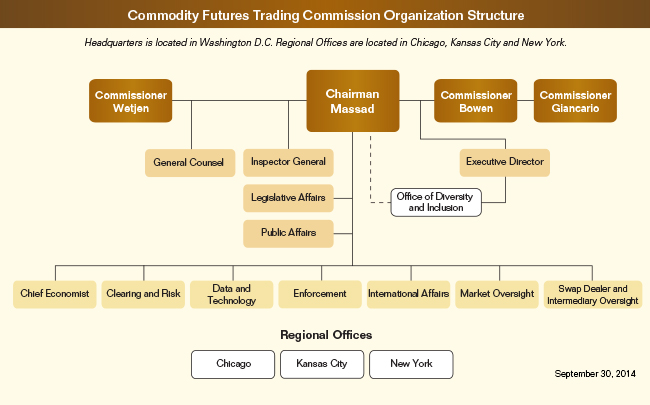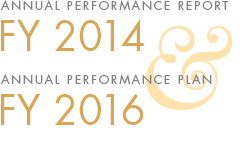
CFTC Mission
To protect market users and the public from fraud, manipulation, abusive practices and systemic risk related to derivatives that are subject to the Commodity Exchange Act,
and to foster open, competitive, and financially sound markets.
A Message from
the Chairman
I am pleased to present the Fiscal Year 2014 Annual Performance Report and Fiscal Year 2016 Annual Performance Plan for the Commodity Futures Trading Commission (CFTC). Together, these reports document the progress we have made over the last fiscal year, and lay out our goals for the year ahead.
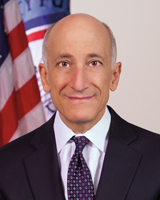
The Fiscal Year (FY) 2014 Annual Performance Review Report (APR) tracks the CFTC’s performance against the goals included in the Commission’s Strategic Plan FY 2011–2015. These goals were developed following passage of the Dodd-Frank Wall Street Reform and Consumer Protection Act (Dodd-Frank Act), which expanded the CFTC’s responsibilities to include regulation and oversight of the swaps market. In FY 2014, the CFTC met 41 percent of its metrics, roughly in line with the results in the prior year.
Over the past year, implementation of the new framework to bring the over-the-counter (OTC) swaps market out of the shadows has continued to be a significant priority. As we have increased the percentage of OTC swaps that are centrally cleared, we have also been working to make sure that clearinghouses have the resources and necessary safeguards to operate in a fair, transparent, and efficient manner. Another priority has been to fine-tune our rules so that we make sure commercial end-users can continue to use these markets effectively and efficiently. The Commission took a number of steps in this regard, including actions to exempt end-users from requirements to post margin, addressing end-user concerns regarding the posting of collateral, reducing reporting and recordkeeping requirements in certain areas, and clarifying the treatment of forward contracts. Enforcement has also continued to be a key priority, as a robust compliance and enforcement program is crucial to maintaining the integrity of our markets, as well as public confidence. We have pursued several significant enforcement matters, ranging from traditional Ponzi schemes and precious metal scams that target retirees, to complex manipulation schemes driven by sophisticated, electronic trading strategies, to price fixing or benchmark manipulation through collusion among some of the world’s largest banks.
While we made progress in many areas during FY 2014, as the APR documents, we did not meet performance targets in many areas. One significant reason is our budget. We have a dedicated staff who work very hard, but our resources are often stretched too thinly. For example, because of resource constraints, we did not meet performance targets for risk-based examinations entities that we oversee, including clearinghouses, exchanges, and swap dealers. We will continue to do all we can with the resources we have, but the fact is that budget constraints have impaired our ability to meet our targets in key areas of our responsibility.
The futures, options, and swaps markets that the CFTC oversees are critical to our economy. They enable businesses of all types to manage risk, and these markets profoundly affect the prices we all pay for food, energy, and most other goods and services we buy each day. In normal times, these markets create substantial, but largely unseen, benefits for American families. During the 2008 financial crisis, however, they created just the opposite. The build-up of excessive risk accelerated and greatly intensified the crisis, which was the worst since the Great Depression—millions of jobs lost and homes foreclosed, countless retirements and educations deferred, and businesses shuttered.
This is why the work of the CFTC is so important. We must make sure that farmers, ranchers, manufacturers, and other companies can continue to use these markets effectively to manage risk. And we must do all we can to make sure that the type of excessive risks related to derivatives that contributed to the financial crisis do not happen again.
Over the last several years, the derivatives markets have grown substantially in scale, technological sophistication, and complexity. The number of actively traded futures and options contracts, for example, has doubled since 2010. Derivatives trading is increasingly conducted in an automated, electronic fashion.
For the derivatives markets to work well for the businesses that need them, a framework of sensible oversight that promotes market integrity and transparency, as well as competition and innovation, is vital. To conduct surveillance of today’s markets requires very sophisticated technological capabilities, as well as highly-skilled professionals who can monitor, analyze, and interpret vast amounts of data. Cybersecurity is another area that is of ever-increasing importance. Cyberattacks are more frequent and sophisticated than ever before. They represent a significant risk to financial stability. We must do all we can to enhance readiness, including more frequent and robust examinations of clearinghouses, exchanges, and market participants. Likewise in the area of enforcement, the expansion and evolution of the markets we oversee has been a challenge. We have brought many important enforcement actions, and collected fines and penalties between FY 2009 and FY 2014 that were twice our cumulative budgets, which monies go to the U.S. Department of the Treasury and do not fund our budget. Indeed, in the first four months of FY 2015, fines and penalties collected were six times our budget. But for every case we bring, there are many more leads we would like to pursue.
The CFTC’s capabilities and resources must match the scale and sophistication of the derivatives markets today. That means making sure that we are making smart investments and focusing our resources to be as effective as possible. To that end, last year, the Commission developed a new strategic plan that reflects the CFTC’s broadened responsibilities and market developments.
The new FY 2014–2018 CFTC Strategic Plan, which the Commission approved in October 2014, sets out an updated set of performance measures, designed to drive excellence, promote efficiency, and help us execute on our mission. The Commission will use the strategic plan to measure its progress going forward. As part of the new strategic plan, we also developed an Information Technology Strategic Plan, which provides direction for how technology will support our expanded mission, and improve efficiency and effectiveness. Corresponding to the new strategic plan, the second portion of this report is the FY 2016 Annual Performance Plan (APP), which sets forth our goals and priorities. Going forward, the CFTC will publish this report to set out our strategic goals and our progress in accomplishing them.
We will focus our efforts on four broad goals: market integrity and transparency, financial integrity and avoidance of systemic risk, comprehensive enforcement, and domestic and international cooperation and coordination. Each of these goals cuts across the Commission’s operational groups, and each is vital to fulfilling our mission. As described in the APP, these goals will help us fulfill our mission to foster open, transparent, competitive, and financially sound derivatives markets, to mitigate systemic risk, and to protect market participants and the public from fraud, manipulation, and abuse.
In addition, the APP includes specific management goals designed to make sure the CFTC can attract and maintain a workforce capable of carrying out our mission and that the Commission is a prudent steward of public funds.
The United States has had the best derivatives markets in the world for decades—the largest, most dynamic, and most innovative. They have served the needs of farmers, ranchers, manufacturers, and other businesses well. The strength of our markets is due in part to the fact that we have maintained a sensible regulatory framework that has helped to insure integrity and transparency and attracted market participants from around the world. With an appropriate level of resources and sensible oversight, our derivatives markets can continue to be second to none.
![]()
Timothy G. Massad
February 25, 2015
Overview
Overview presents key information regarding the CFTC FY 2014 Annual Performance Report. See below for details on the various sections.
-
Introduction
This document presents the CFTC Annual Performance Report (APR) for Fiscal Year 2014 and the Annual Performance Plan (APP) for Fiscal Year 2016. It is prepared in accordance with the requirements of the Government Performance and Results Act (GPRA) Modernization Act of 2010 (GPRAMA) and Office of Management and Budget (OMB) Circular A-11 Part 6. This report includes performance measure analysis and review of each of the five strategic goals and the tactical goal for Dodd-Frank Act rulemaking.
History
Congress established the CFTC as an independent agency in 1974, after its predecessor operated within the U.S. Department of Agriculture. Its mandate was renewed and/or expanded in 1978, 1982, 1986, 1992, 1995, 2000, 2008, and 2010. The CFTC and its predecessor agencies were established to protect market participants and the public from fraud, manipulation, and other abusive practices in the commodity futures and options markets. After the 2008 financial crises and the subsequent enactment of the Dodd-Frank Act, the CFTC’s mission expanded to include oversight of the swaps marketplace.
The Commission administers the Commodity Exchange Act (CEA), 7 U.S.C. section 1, et seq. The CEA brought under Federal regulation futures trading in all goods, articles, services, rights, and interests; commodity options trading; and leverage trading in gold and silver bullion and coins; and otherwise strengthened the regulation of the commodity futures trading industry. It established a comprehensive regulatory structure to oversee the volatile futures trading complex.
On July 21, 2010, President Obama signed the Dodd-Frank Act, which amended the CEA to establish a comprehensive new regulatory framework for swaps, as well as enhanced authorities over historically regulated entities. Title VII of the Dodd-Frank Act, which relates to swaps, was enacted to reduce systemic risk, increase transparency, and promote market integrity within the financial system.
The U.S. futures and swaps markets are estimated at $30 trillion and $400 trillion, respectively. By any measure, the markets under CFTC’s regulatory purview are large and economically significant. Given the enormity of these markets and the critical role they play in facilitating price discovery and hedging of risk, ensuring that these markets are transparent, open, and competitive is essential to their proper functioning and to help safeguard the financial stability of the Nation.
In February 2011, the Commission published a new strategic plan, CFTC FY 2011–2015 Strategic Plan (http://www.cftc.gov/reports/strategicplan/2015/index.htm), integrating the expanded responsibilities under the Dodd-Frank Act with its existing mission and goals. The regulation of swaps has been incorporated into the regulatory structure that has existed for futures and options markets. The CFTC has been working to write the rules Congress mandated to regulate the swaps markets, implement those rules, test and adjust those rules, and write new rules as necessary to bring effective regulation to all derivatives markets over the five-year period.
The focused rule-writing effort to complete the remaining 6 rules required by the Dodd-Frank Act remains a tactical goal that has an objective, strategy, and performance measure associated with it. Developing and implementing the Dodd-Frank Act rules is one of the most important and difficult efforts the Commission has ever undertaken. The Dodd-Frank Act set a timeframe of 360 days (or less in a few instances) for completion of the rules, but the Commission was unable to comply with this for several reasons:
- Commission’s continued budget constraints;
- Commitment to significant and open interaction with Congress; market participants; the public; and other regulators, both domestic and international; and
- Expanded rule complexity.
The comment and consideration aspects of the rulemaking process take an enormous amount of time. The Commission has and will continue to ensure all appropriate thought is given to rule development.
The Commission is committed to transparency in the rulemaking process. As such, the Commission maintains a list of all of its meetings relating to the implementation of the Dodd-Frank Act, as well as the participants, issues discussed, and all materials provided to the Commission, on its website at http://www.cftc.gov/LawRegulation/DoddFrankAct/ExternalMeetings/index.htm.
-
About This Report
The FY 2014 APR and FY 2016 APP provides an overview of the CFTC’s performance results relative to its mission in order to help Congress, the President, and the public assess the CFTC’s stewardship over the financial resources entrusted to it. The report is organized by strategic goal and performance measure, and provides detail on how each contributes to the Commission’s overall mission. The report provides information about the Commission’s performance as an organization, its achievements, and its challenges.
The APR/APP meets a variety of reporting requirements stemming from numerous laws focusing on improved accountability among Federal agencies and guidance described in OMB Circulars A-11 and A-136.
Suggestions for improving this document can be sent to the following address:
Commodity Futures Trading Commission
Business Management and Planning Branch
Three Lafayette Centre
1155 21st Street, NW
Washington, DC 20581The Commission’s annual reporting includes the following four components described to the right. When complete, these reports are available on the Commission’s website at
http://www.cftc.gov/About/CFTCReports/index.htm.Agency Financial Report (AFR)
Available December 2014. The AFR is a report on the Commission end of year financial position that includes, but is not limited to, financial statements, notes to the financial statements, and a report of the independent auditors.
Annual Performance Report (APR)
Available February 2015. The APR is a report on the Commission’s performance that is available to Congress with the Congressional Budget Justification in February. The APR contains information on the CFTC’s progress to achieve goals during the previous year.
Annual Performance Plan (APP)
Available February 2015. Under the GPRAMA, an agency’s APP defines the level of performance to be achieved during the year in which the plan is submitted and the next fiscal year. The APP may be used to structure the Commission’s budget submission or be a separate document that accompanies the CFTC’s budget submission. An APP must cover each program activity of the Commission set forth in the budget.
Summary of Performance and
Financial Information (SPFI)Available February 2015. This document provides an integrated overview of performance and financial information that integrates significant aspects of the AFR and the APR into a user-friendly consolidated format.
-
The Organization
-
CFTC Organizational Programs
Below are brief descriptions of the organizational programs within the CFTC.
The Commission
The Offices of the Chairman and the Commissioners provide executive direction and leadership to the Commission. The Offices of the Chairman include Public Affairs and Legislative Affairs.
Division of Clearing and Risk (DCR)
The DCR program supervises the derivatives clearing organizations (DCOs) that clear futures, options on futures, and swaps, which involves supervision of DCOs and surveillance of other market participants that may pose risk to the clearing process, including futures commission merchants (FCMs), swap dealers (SDs), major swap participants (MSPs), and large traders. The DCR staff: 1) prepare proposed and final regulations, orders, guidelines, exemptions, interpretations, and other regulatory work products on issues pertaining to DCOs and, as relevant, other market participants; 2) review DCO applications and rule submissions and make recommendations to the Commission; 3) make recommendations to the Commission as to categories of swaps that should be subject to mandatory clearing determinations; 4) make recommendations to the Commission as to the initial eligibility or continuing qualification of a DCO to clear swaps; 5) assess compliance by DCOs with the CEA and Commission regulations, including examining systemically important DCOs (SIDCOs) at least once a year; 6) conduct risk assessment and financial surveillance through the use of risk assessment tools, including automated systems to gather and analyze financial information, and identify, quantify, and monitor the risks posed by DCOs, clearing members, and market participants and their financial impact; 7) evaluate new DCO margin models and enhancements to existing margin models; 8) review DCO notifications regarding systems disruptions, material planned changes to mission critical systems or programs of risk analysis and any other notifications that potentially impact the DCO’s ability to process, clear, and risk manage its business activities; 9) work with staff of the Board of Governors of the Federal Reserve, the U.S. Securities and Exchange Commission (SEC), and other financial regulatory agencies to analyze risk issues related to central counterparty (CCP) clearing; and 10) working with the Office of International Affairs (OIA), participate in the work of international regulators in setting worldwide standards with respect to CCPs and their members, and in evaluating the application of those standards.
Division of Enforcement (DOE)
The DOE program investigates and prosecutes alleged violations of the CEA, the Dodd-Frank Act, and Commission regulations. Possible violations include manipulation, disruptive trading, fraud, capitalization and segregation deficiencies, supervisory violations, and other abuses concerning derivatives that are traded on U.S. exchanges, and threaten market integrity, market participants, and the general public. The Whistleblower Office (WBO), a component of the DOE, performs the ministerial functions and determination of preliminary award eligibility, and guides the anti-retaliation protections of whistleblower matters as needed during examination, investigation, and litigation.
Division of Market Oversight (DMO)
The DMO program fosters markets that accurately reflect the forces of supply and demand for the underlying commodities and are free of disruptive activity. To achieve this goal, program staff oversee trade execution facilities, perform market and trade practice surveillance, review new exchange applications, and examine existing exchanges to determine their compliance with the applicable core principles. Other important work includes evaluating new products to make certain that they are not susceptible to manipulation, and reviewing exchange rules and actions to ensure compliance with the CEA and CFTC regulations.
Division of Swap Dealer and Intermediary Oversight (DSIO)
The DSIO program oversees the registration and compliance activities of intermediaries and the futures industry self-regulatory organizations (SROs), which include the U.S. derivatives exchanges and the National Futures Association (NFA). Program staff develop and implement regulations concerning registration, fitness, financial adequacy, sales practices, protection of customer funds, crossborder transactions, and anti-money laundering programs, as well as policies for coordination with foreign market authorities and emergency procedures to address market-related events that impact intermediaries. The DSIO monitors the compliance activities of these registrants and provides oversight and guidance for complying with the system of registration and compliance established by the CEA and Commission’s regulations. Concurrently, the DSIO evaluates the effectiveness of registrant governance and internal oversight through targeted reviews and examinations, oversight of examinations performed by SROs, and a focus on the activities of the risk managers and chief compliance officers. The DSIO also reviews whether registrants maintain sufficient financial resources, risk management procedures, internal controls, and customer protection practices to enhance the financial stability of market participants and transparency in the markets.
Office of the Chief Economist (OCE)
The OCE provides economic analysis and advice to the Commission, conducts research and provides advice on policy issues facing the Commission, and educates and trains Commission staff. The OCE plays an integral role in the development and implementation of Commission regulations by providing economic expertise and considering the costs and benefits of these regulations. The OCE also plays a key analytical role in the Commission’s efforts to leverage the enhanced data available under the new regulatory framework.
Office of Data and Technology (ODT)
The ODT is led by the Chief Information Officer and delivers services to CFTC through three components: systems and services, data management, and infrastructure and operations. Systems and services focuses on several areas: market and financial oversight and surveillance; enforcement and legal support; document, records, and knowledge management; CFTC-wide enterprise services; and management and administration. Systems and services provides access to data and information, platforms for data analysis, and enterprise-focused automation services. Data management focuses on data analysis activities that support data acquisition, utilization, management, reuse, transparency reporting, and data operations support. Data management provides a standards-based, flexible data architecture; guidance to the industry on data reporting and recordkeeping; reference data that is correct; and market data that can be efficiently aggregated and correlated by staff. Infrastructure and operations organizes delivery of services around network infrastructure and operations, telecommunications, and desktop and customer services. Delivered services are widely available, flexible, reliable, and scalable, supporting the systems and platforms that empower staff to fulfill the CFTC mission. The three service delivery components are unified by an enterprise-wide approach that is driven by the Commission’s strategic goals and objectives and incorporates information security, enterprise architecture, and project management.
Office of the General Counsel (OGC)
The OGC provides legal services and support to the Commission and all of its programs. These activities primarily include: 1) providing advice on complex questions of statutory and regulatory interpretation arising under the CEA; 2) representing the Commission in U.S. Courts of Appeals, amicus curiae litigation, industry bankruptcies, defense of rule challenges, and other litigation; 3) providing legal support and advice in connection with other relevant Federal statutes; 4) assisting the Commission in the performance of its adjudicatory functions; and 5) providing advice on legislative and other intergovernmental issues.
Office of International Affairs (OIA)
The OIA advises the Commission regarding international regulatory initiatives; provides guidance regarding international issues raised in Commission matters; represents the Commission in international organizations, such as the International Organization of Securities Commissions (IOSCO); coordinates Commission policy as it relates to policies and initiatives of major international jurisdictions, the G-20, the Financial Stability Board (FSB), and the U.S. Department of the Treasury (Treasury); and provides technical assistance to international market authorities.
Office of the Inspector General (OIG)
The OIG is an independent organizational unit at the CFTC. The mission of the OIG is to detect waste, fraud, and abuse and to promote integrity, economy, efficiency, and effectiveness in the CFTC’s programs and operations. As such it has the ability to review all of the Commission’s programs, activities, and records. In accordance with the Inspector General Act of 1978, as amended, the OIG issues semiannual reports detailing its activities, findings, and recommendations.
Office of the Executive Director (OED)
The Commission’s ability to achieve its mission of protecting the public, derivative market participants, U.S. economy, and the U.S. position in global markets is driven by well-informed and reasoned executive direction; strong and focused management; and an efficiently-resourced, dedicated, and productive workforce. These attributes of an effective organization combine to lead and support the critical work of the Commission to provide sound regulatory oversight and enforcement programs for the U.S. public. The Executive Director ensures the Commission’s continued success, continuity of operations, and adaptation to the ever-changing markets it is charged with regulating; directs the effective and efficient allocation of CFTC resources; develops and implements management and administrative policy; and ensures program performance is measured and tracked Commission-wide. The OED includes the following programs: Business Management and Planning, Consumer Outreach, Executive Secretariat, Financial Management, and Human Resources.
-
Strategic Framework
The following table is an overview of the Commission’s mission statement, strategic goals and objectives under the FY 2011–2015 strategic framework:
Mission Statement
To protect market users and the public from fraud, manipulation, abusive practices and systemic risk related to derivatives that are subject to the Commodity Exchange Act, and to foster open, competitive, and financially sound markets.Strategic Goal One
Protect the public and market participants by ensuring market integrity, promoting transparency,
competition and fairness and lowering risk in the system.Objectives - Ensure that markets are structured to reflect the forces of supply and demand for the underlying commodity and are free from manipulation, disruptive activity and abusive trading practices.
- Ensure that U.S. DCMs and SEFs have the systems, procedures and resources necessary for effective self-regulation and ongoing compliance with core principles.
- Promote transparency by producing and publishing summary market statistics for the futures, options and swaps markets.
Strategic Goal Two
Protect the public and market participants by ensuring the financial integrity of derivatives transactions,
mitigation of systemic risk, and the fitness and soundness of intermediaries and other registrants.Objectives - Clearing organizations and firms participating in the derivatives industry are financially sound.
- Registered intermediaries meet standards for fitness and conduct.
- Ensure that self-regulatory organizations fulfill their financial surveillance responsibilities.
- Ensure that information technology systems support the Commission’s existing and expanded responsibilities to ensure financially sound markets, mitigate systemic risk, and monitor intermediaries
Strategic Goal Three
Protect the public and market participants through a robust enforcement program.
Objectives - Identify and stop violations of the Commodity Exchange Act and Regulations; deter others from engaging in future misconduct.
- Increase cooperative enforcement.
Strategic Goal Four
Enhance integrity of U.S. markets by engaging in cross-border cooperation, promoting strong international regulatory standards, and encouraging ongoing convergence of laws and regulation worldwide.
Objectives - Cooperate and coordinate with domestic and foreign regulatory authorities.
- Promote high levels of internationally accepted standards of best practice.
- Provide global technical assistance.
Strategic Goal Five
Promote Commission excellence through executive direction and leadership, organizational and individual performance management, and effective management of resources.
Objectives - An organizational structure that is aligned and streamlined to operate and carry out its mission efficiently and effectively.
- Effectively respond to the regulatory needs of a dynamic and complex derivatives market place and efficiently allocate limited resources to the highest priority activities
- Attract, engage, develop and retain an exceptionally qualified, diverse, and productive workforce.
- Information technology supports and enhances mission accomplishment through effective and efficient infrastructure, systems and services.
- Ensure effective stewardship and management of CFTC financial resources.
-
Summary of Performance
The following sections include a high-level discussion of each of the five strategic goals and the tactical goals for Dodd-Frank Act rulemaking, as well as a detailed analysis and review of each performance measure (shortfalls and successes). The accomplishments demonstrate progress made in FY 2014 toward the achievement of the Commission’s mission and strategic goals. However, in many areas progress was limited by resource constraints and reallocations in an attempt to maintain progress toward writing and implementing the new rules required under the Dodd-Frank Act. The Commission’s regulatory purview has expanded in scope, scale and complexity with the passage of the Dodd-Frank Act and the increased use of technology in the markets in the last five years. However, the Commission was not provided with the commensurate increase in budget authority to oversee the markets and market participants over that period of time. These constraints have limited the effectiveness of the Commission in carrying out its mission.
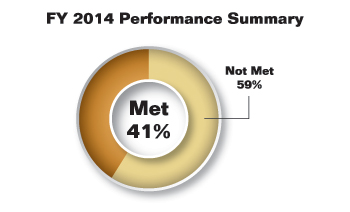
In FY 2015, the Commission will begin monitoring and analyzing strategic objectives outlined in the new Strategic Plan which spans FY 2014 to FY 2018. This new strategic plan will have a different set of performance goals across the Commission, many of which are new goals. The CFTC plans to monitor these goals on a quarterly basis, provide better and more frequent assessments to leadership, and provide division and office directors more time to make adjustments where warranted.
Some performance measures described in the current FY 2011 to FY 2015 Strategic Plan are dependent upon the completion of specific rules or remained in development from the onset of the Strategic Plan. As a result, five of the 54 performance measures were considered “Not Applicable” during the FY 2014 reporting period.
The following identifies the specific performance measures considered “Not Applicable”:
- 1.1.1.2 Implement automated surveillance alerts and a case management system.
- 1.1.2.1 Review information requirements of current and proposed forms.
- 1.1.3.1 Transmit information and consult with the Office of Information Technology Services (OITS) [Now recognized as the Office of Data and Technology—ODT] to implement electronic filing of forms. Fully deploy electronic filing of trader reporting forms.
- 3.1.1.2 The CFTC will bring claims in due recognition of the broadened enforcement mandate provided by the Dodd-Frank Act, and will seek proportionate remedies, including civil monetary penalties, undertakings and restitution, that have the highest impact on and greatest deterrent effect against potential future violations.
- 4.1.1.2 Regular issuance of outgoing international requests for enforcement assistance and referrals made by the CFTC to foreign regulators pertaining to matters involving their jurisdictions.
The following performance measures have been completed:
- 5.1.1.1 Executive approval and Commission adoption of efficient and effective organizational design.
- 5.3.1.1 Assess, develop, and implement automated hiring system.
- 5.3.3.1 Develop and implement comprehensive development and education program.
- 5.5.2.1 Management control reviews are conducted and documented. Recommendations are implemented. The Chairman and the Chief Financial Officer (CFO) are able to give unqualified Federal Managers’ Financial Integrity Act (FMFIA) management assurances.
- 5.5.3.1 Implement web-based time and attendance system.
The performance measures in this report are rated as: Met, or Not Met. Overall results for the Commission’s performance measures are depicted in the following table:
CFTC Performance Results # of Measures1 Met Not Met All Goals 44 18 26 % of Total 41% 59% 1 Excludes five performance measures categorized as “Not Applicable” and five performance measures that were completed prior to FY 2014. (back to text) -
Looking Ahead
A new Strategic Plan spanning FY2014 to FY 2018 will be introduced starting in the next FY 2015 performance cycle. The new Strategic Plan will monitor a new set of performance goals (previously performance measures).
In building the new FY 2014–2018 Strategic Plan, the CFTC evaluated the effectiveness and usefulness of previous measures in conveying program success. While the Commission believes that in aggregate, they provide an accurate portrayal of progress, the Commission saw the opportunity to improve in a couple of key areas. First, performance goals are most useful when each division or office director is held accountable for these goals and strategies. Updating the goals twice a year meant that directors had little or no time to make course corrections if their programs were underperforming. Second, with the administration-wide push to develop outcome based measures, the CFTC had the opportunity to revise several output based measures to make them more informative. Finally, the Commission tied the performance goals to the broader strategic goals and objectives instead of individual strategies, which should be a better gauge of program success.
A top down approach was used to build the FY 2014 to FY 2018 performance goals. The first priority was to analyze each strategic goal and strategic objective to isolate key variables that indicate whether progress is being made. This is an especially difficult task as many of the goals and objectives are abstract in nature (e.g., measuring the susceptibility of markets to manipulation and other abusive practices). Accordingly, the CFTC developed multiple performance goals per strategic goal and in some cases per strategic objective. When viewed together, the Commission believes they will display whether true progress is being made towards the goal.
The result is 38 performance goals across the Commission, many of which are new goals. In FY 2014 and FY 2015, these will be baselined with targets established in the APP. The CFTC plans to monitor these goals on a quarterly basis, provide better and more frequent assessments of accomplishments to leadership, and provide division and office directors more time to make adjustments where warranted.
The CFTC will seek greater accountability by developing annual operational plans. These operational plans tie the strategic goals and objectives with tactical requirements. The goals, objectives, and strategies will also be included in the annual performance evaluations of the office or division director or particular staff charged with implementing the goals, objectives, and strategies.
Performance Analysis
and Review
Performance Analysis and Review presents an overview as well as details for Objective 0.1 and the five Strategic Goals. See below for information on each goal including introduction, performance measures, performance results, and performance analysis and review.
-
-
Overview
The remaining portion of this report details the Commission’s efforts to meet its rulemaking objectives, strategic goals, and performance targets as described in the Strategic Plan. Each strategic goal is summarized with high-level achievements before leading into a detailed performance analysis and review narrative for each associated measure. For reference purposes, each performance measure is uniquely identified using the following hierarchical structure:
Strategic Goal.Objective.Strategy.Performance Measure (e.g., 1.1.1.1)
Appendix B, “CFTC Performance Measures and Results,” provides a summary of performance measure information in table format for FY 2011 and 2012 Actual; FY 2013 Actual; and FY 2014 Planned and Actual. Performance measures which were rule-dependent (Dodd-Frank Act) and/or others considered “Not Applicable” during FY 2014 have been listed after the table in a section titled “Performance Measures Considered Not Applicable in FY 2014.”
-
Objective 0.1—Complete all Dodd-Frank Act rule development requirements within the statutory deadlines.
PERFORMANCE MEASURE 0.1.1.1 Complete all Dodd-Frank Act rules within statutory time frames. Percentage of rules complete.
FY 2014 Target: 100%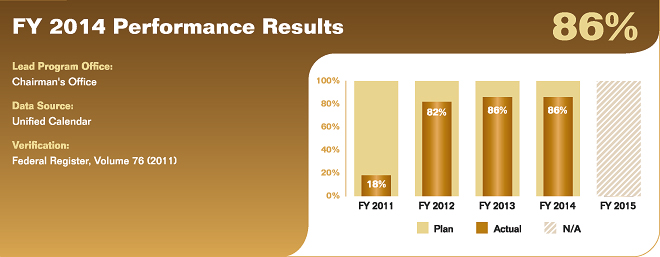
Performance Analysis & Review
The performance target was not met for FY 2014. The Dodd-Frank Act set a timeframe of 360 days (or less in a few instances) for completion of the rules. The Commission has been unable to accomplish this for several reasons. Primarily, the continued delay is a matter of capacity for rule consideration. With all rules, the CFTC has taken, and will continue to take, a thoughtful and balanced approach. The Commission actively seeks and takes into full consideration public comments regarding the costs, benefits, and economic effects of proposed rules. Given the significance of the rules and consequent public interest, it has taken substantial time and resources to accomplish this. Several other variables contributed to the delay.
- To ensure development and implementation of rules that are well balanced between risk mitigation and cost to the industry and public, additional meetings and opportunities for public input with Congress, industry, and the public were necessary and appropriate; and
- While some rules are fairly straight forward, many are intricate and raise interrelated and complex issues. Staff members require the appropriate time to analyze, summarize, and consider the additional public input that has been sought, and develop draft final rules for deliberation by the Commission.
Despite the above limitations placed on the Commission since the onset of the massive undertaking, it was able to accomplish the following Dodd-Frank Act related rulemaking tasks through September 30, 2014:
- Issued 74 proposed rules and issued 64 final rules;
- Received, reviewed, and analyzed approximately 36,000 comments; and
- Held 16 technical conferences/roundtables.
Remaining rules to be finalized by the Commission as mandated by the Dodd-Frank Act are as follows:
- Capital Requirements for Swap Dealers and Major Swap Participants (76 FR 27802);
- Margin Requirements for Uncleared Swaps for Swap Dealers and Major Swap Participants (79 FR 59898);
- Governance Requirements for Designated Contract Markets and Swap Execution Facilities; Additional Requirements Regarding the Mitigation of Conflicts of Interest (76 FR 722);
- Requirements for Designated Contract Markets and Swap Execution Facilities Regarding the Mitigation of Conflicts of Interest (75 FR 63732);
- Position Limits for Commodity Derivatives Contracts (78 FR 75680); and
- Annual Stress Test (§ 165(i); this rule has not been proposed).
-
-
-
Goal One—Protect the public and market participants by ensuring market integrity, promoting transparency, competition and fairness and lowering risk in the system.
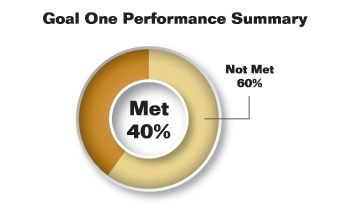
Derivatives markets are designed to provide a means for market users to offset price risks inherent in their businesses and to act as a public price discovery platform from which prices are broadly disseminated for public use. For derivatives markets to fulfill their role in the national and global economy, they must operate efficiently and fairly, and serve the needs of market users. The markets best fulfill this role when they are open, competitive, and free from fraud, manipulation, and other abuses such that the prices discovered on the markets reflect the forces of supply and demand.
The Commission strives to assure that Goal One is effectively met through the combined use of four oversight strategies: 1) review of new contracts and rules, and amendments to existing contracts and rules; 2) surveillance of trading activity in the futures and swaps markets; 3) review of regulated exchanges, designated contract markets (DCMs), Swap Execution Facilities (SEFs) and swap data repositories (SDRs) to verify whether they are fulfilling their self-regulatory obligations; and 4) adoption of policies and strategies to promote market transparency.
Accomplishments related to progress in achieving this goal include:
- Completed and began implementing the rules providing registration and operation requirements for SEFs that became effective on May 16, 2013, and provisionally registered 22 SEFs by May 9, 2014.
- Completed three rule enforcement reviews (RERs) of DCMs. These include RERs of the North American Derivatives Exchange (NADEX) in November 2013, OneChicago in April 2014, and ICE Futures U.S. in July 2014.
- Completed reviews of 80 new product certifications, nine exempt market filings, 932 rule filings, 24 foreign security index certifications, and one Foreign Board of Trade no action request. Completed reviews of all SDR applications for provisional registration.
- Issued an amendment to 17 CFR §49.17(f)(2) adopting an interim final rule to clarify the scope of permissible access by market participants to swap data and information maintained by a registered SDR. This rule provides an exception for data and information related to a particular swap that is maintained by the registered SDR to be accessible by either counterparty to that particular swap.
- Continued its efforts to monitor futures commission merchants (FCMs) by conducting various direct and horizontal limited scope reviews while reviewing over 1,200 financial filings and 1,700 notices. The new horizontal reviews focused on the liquidity of FCMs, the sufficiency of excess segregation and secured requirements, risk management, and internal controls at FCMs. With the assistance of the designated self-regulatory organizations (DSROs), the Commission also successfully managed the wind down and transfer customer accounts of four FCMs in financial distress.
- Streamlined and completed approximately half of its sampling review work in connection with the process of registering two new categories of registrants—swap dealers (SDs) and major swap participants (MSPs). The CFTC provided extensive interpretive guidance to NFA in its front line registration activities.
- Finalized the Volcker Rule with the Federal Reserve Board, Office of the Comptroller of the Currency, Federal Deposit Insurance Corporations, and SEC, and coordinated with those agencies in responding to numerous frequently asked questions and interpretive inquiries. The CFTC also developed the database systems and worked with the other agencies and banking entities to prepare for and begin receiving the required Volcker reporting metrics data in a standardized format.
- Continued the use of Special Call Authorities, which require entities to provide data and market behavior explanations not normally available to the CFTC, in conjunction with data already within or available to the Commission to detect compliance violations and manipulation for further referral for investigation to the DOE.
- Completed the “Made Available to Trade” rulemaking, effective on May 16, 2013, that allows a DCM or SEF to subject a swap that it determines is “available to trade” to the trade execution requirement.
- Drafted two significant IOSCO reports: the report on over-the-counter (OTC) derivatives data reporting and aggregation requirements, and the report on trading of OTC derivatives.
- Created three new automated alerts and three new reports and enhanced four trade practice alerts, providing for a more efficient and effective market and trade surveillance program.
Goal One performance measure results are depicted in the following table:
Goal One Performance Results # of Measures2 Met Not Met Goal One 10 4 6 % of Total 40% 60% 2 Excludes three performance measures categorized as “Not Applicable” for FY 2014. (back to text) -
Goal One performance measures, analysis and review – Objective 1.1
PERFORMANCE MEASURE 1.1.1.1 Implement automated position limit alerts for futures, option, and swaps markets.
FY 2014 Target: Implement automated position limit monitoring for all commodities under CFTC position limits using integrated data from reporting firms and swaps data repositories.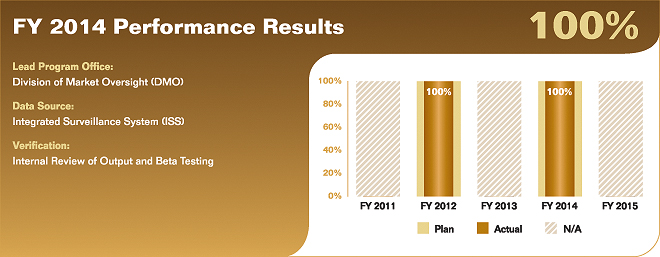
Performance Analysis & Review
The performance target was met for FY 2014. The Commission is working to design a system for detecting speculative position limit violations under Commission Regulation 150.2. The remaining part of the build-out is to write the code that will account for hedge exemptions enumerated under Commission Regulations 1.3(z), 1.47, and 1.48.
PERFORMANCE MEASURE 1.1.1.3 Implement automated trading violation alerts and a case management system.
FY 2014 Target: Implement two automated trading violation alerts.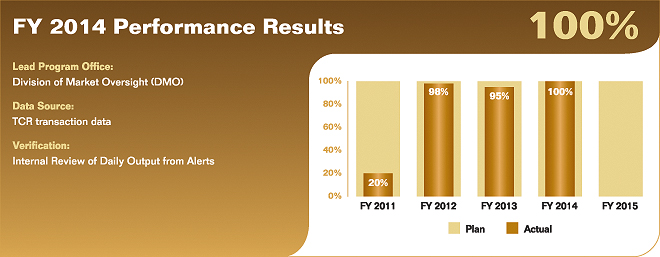
Performance Analysis & Review
The performance target was met for FY 2014. Staff finished and implemented an Exchange of Futures for Related Products (EFRP) In & Out Engine as well as a Relational Trade Engine that finds Exchanges of Futures for Futures. Staff also created code designed to generally detect EFRPs and allow staff to conduct further review of those transactions.
PERFORMANCE MEASURE 1.1.4.1 Percentage of contracts that are reviewed, in a timely manner, following a finding of market significance, and determined to be in compliance with core principles
or referred back to exchange for modification.
FY 2014 Target: 100%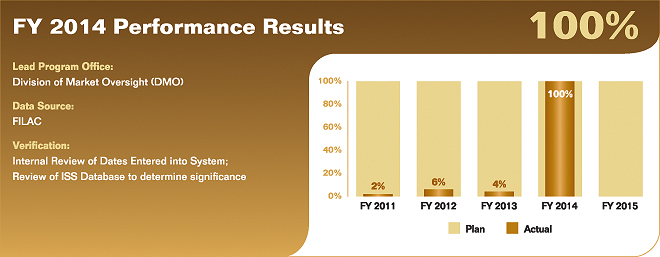
Performance Analysis & Review
The performance target was met for FY 2014. The Commission conducts an initial cursory review of every new product filed with the Commission to determine whether the product appears to comply with the CEA. Full review of contract filings that appear to comply with the CEA typically is deferred until such time that resources are available for full review. Otherwise, the Commission notifies the submitting exchange if a product filing appears to violate the CEA with a recommendation to withdraw or amend the filing. The absence of a full review could result in trading in contracts that may be readily susceptible to manipulation or that are subject to inappropriate position limits. Trading in such contracts could cause distortions in the prices of the underlying and related commodities and adversely affect hedging by commercial entities.
PERFORMANCE MEASURE 1.1.5.1 Rule submissions are reviewed and a determination is made regarding compliance with the CEA, or referred back to the exchange for correction, as amended by the Dodd-Frank Act and Commission regulations within the required 10-day or 90-day time period.
FY 2014 Target: 100%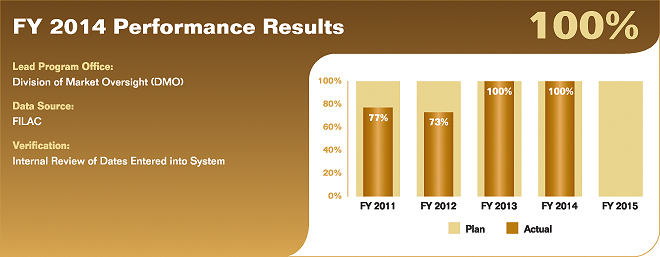
Performance Analysis & Review
The performance target was met for FY 2014. Product Review Rule Amendments equals 263 submissions reviewed out of 263 submissions received. EDR Rule Amendment Submissions equals 799 submissions reviewed out of 799 submissions received.
PERFORMANCE MEASURE 1.1.6.1 DCM and SEF applications are reviewed and a determination
is made regarding compliance with core principles within statutory time frames.
FY 2014 Target: 100%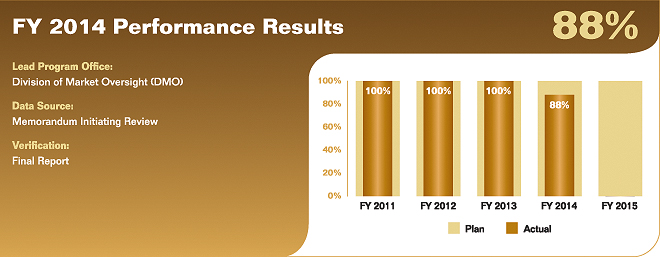
Performance Analysis & Review
The performance target was not met for FY 2014. Application reviews are currently in process. As of September 30, 2014, there were three DCM applications pending; one being finalized for review by the Commission, and two other application reviews are stayed pending staff obtaining necessary information from the applicants.
-
Goal One performance measures, analysis and review – Objective 1.2
PERFORMANCE MEASURE 1.2.1.1 Percentage of major DCMs and SEFs reviewed, during the year. (Structural Sufficiency)
FY 2014 Target: 100%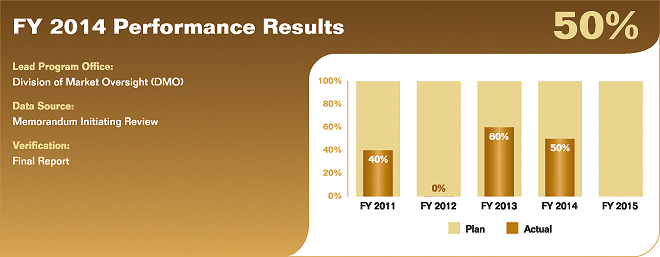
Performance Analysis & Review
The performance target was not met for FY 2014. Examinations staff completed a complex market surveillance RER of ICE Futures U.S. in July 2014. In addition, staff completed three additional RERs of major exchanges in October 2014, just after the end of FY 2014. These RERs include a joint audit trail RER of CME (Chicago Mercantile Exchange) and CBOT (Chicago Board of Trade); a joint trade practice surveillance RER of NYMEX and COMEX; and a joint RER of the disciplinary programs at CME, CBT, NYMEX, and COMEX. Because no SEFs have been permanently registered, there were no RERs of SEFs. In addition to conducting DCM RERs, all Compliance staff devoted a significant amount of time in FY 2014 to reviewing and analyzing SEF applications for full registration and to other DMO projects. Once all SEFs are permanently registered, they will need to be included in the Examinations RER program. Without additional resources, the performance goals for SEFs will not be satisfied. Note: Although CME Group operates four distinct DCMs, for purposes of these performance measures the four DCMs are counted as one because they generally share the same staff, systems, and procedures.
PERFORMANCE MEASURE 1.2.1.2 Percentage of non-major DCMs and SEFs reviewed, during the year. (Structural Sufficiency)
FY 2014 Target: 100%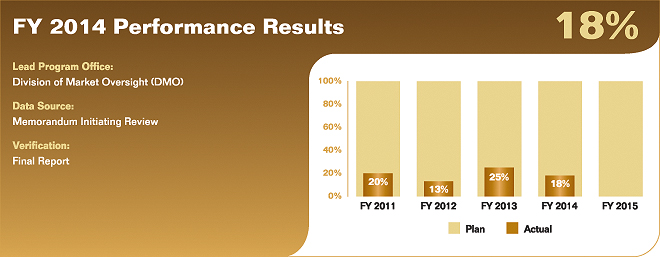
Performance Analysis & Review
The performance target was not met for FY 2014. Examinations staff completed a RER of the NADEX in November 2013 and a RER of OneChicago Exchange in April 2014. Compliance does not have the necessary resources to meet the target performance standard. However, several of the non-major DCMs have little or no trading volume and do not require annual RERs. As with DCMs, it is likely that SEFs will be divided into major and non-major SEFs. Because SEFs are not permanently registered, the Commission has not initiated RERs for either major or non-major SEFs.
PERFORMANCE MEASURE 1.2.2.1 Percentage of major DCMs and SEFs reviewed, during the year. (Automated Systems and Business Continuity)
FY 2014 Target: 100%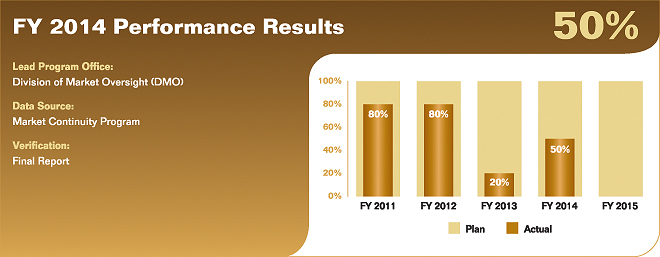
Performance Analysis & Review
The performance target was not met for FY 2014. The Commission has completed a System Safeguards Exam (SSE) for CME Group DCMs. For this performance measure, the four CME Group DCMs are counted as one and not four individual DCMs because CME provides the technology/market continuity related services for all four of the DCMs and there is no distinguishing one among the DCMs in this area. In FY 2014, staff completed all fieldwork and drafted the SSE reports for two additional SSEs, one for CME Group and the other for ICE Futures U.S. However, due to scheduling complications in presenting the examination reports to the Commission for acceptance, both reports will be formally issued in FY 2015.
PERFORMANCE MEASURE 1.2.2.2 Percentage of non-major DCMs and SEFs reviewed, during the year. (Automated Systems and Business Continuity)
FY 2014 Target: 33%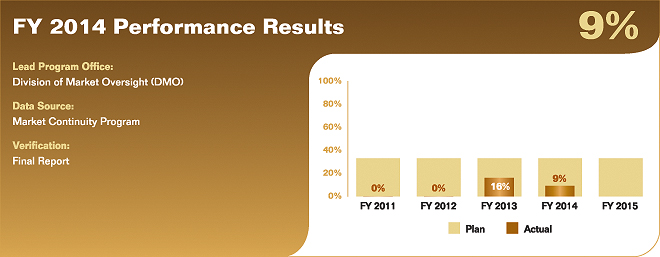
Performance Analysis & Review
The performance target was not met for FY 2014. The Commission has completed an SSE for one of the 11 non-major DCMs (CBOE Futures). The Commission was unable to meet the 33 percent year-end target by doing three additional exams of non-major DCMs due to a severe resource shortage and requirements to review SEF registration applications.
-
Goal One performance measures, analysis and review – Objective 1.3
PERFORMANCE MEASURE 1.3.1.1 Publish reports for swaps markets activity.
FY 2014 Target: Develop and test aggregation methods to group currency, equity, credit and other commodity swap products. Publish swaps market reports for currency, equity, and other commodity swap products. Publish Dodd-Frank Act required semiannual and annual swaps reports for all commodity products under CFTC position limits.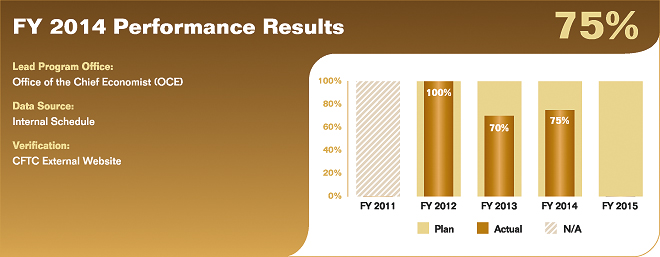
Performance Analysis & Review
The performance target was not met for FY 2014. The Commission has taken all the steps of the development and testing of aggregation methods with respect to the specifically identified categories of swaps conditional on the data supplied to it by the SDRs. There continues to be a high level of dependency on external players delivering clean data to the OCE, delaying the ability to publish semi-annual and annual swaps reports.
Swaps reports are published weekly to CFTC.gov: http://www.cftc.gov/MarketReports/SwapsReports/index.htm.
-
-
-
Goal Two—Protect the public and market participants by ensuring the financial integrity of derivatives transactctions, mitigation of systemic risk, and the fitness and soundness of intermediaries and other registrants.
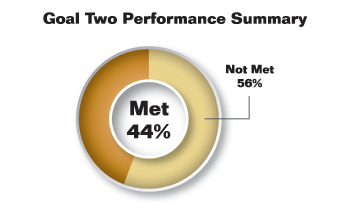
In fostering financially sound markets, the Commission’s main priorities are to avoid disruptions to the system for clearing and settling contract obligations and to protect the funds that customers entrust to futures commission merchants (FCMs), swap dealers (SDs), commodity pool operators (CPOs), commodity trading advisors (CTAs) and other intermediaries. Effective regulatory oversight of clearing and intermediary entities is integral to the financial integrity of derivatives transactions, and by extension, the faith and confidence of market users. Key aspects of the CFTC’s regulatory framework for achieving Goal Two are requiring that: 1) market participants post margin to secure their ability to fulfill financial obligations; 2) participants on the losing side of trades to meet their obligations, in cash, through daily (sometimes intraday) margin calls; 3) FCMs and other intermediaries to maintain minimum levels of operating capital; and 4) FCMs segregate customer funds from their own funds. Additionally, with respect to CPOs and CTAs, a mechanism for monitoring CPOs and CTAs is the data collected through the Forms CPO-PQR and CTA-PR.
Accomplishments related to progress in achieving this goal include:
- Completed annual examinations of systemically important derivatives clearing organizations (SIDCOs), for which the Commission is the Supervisory Agency. The Commission selected the system safeguards core principle, with an emphasis on information security, for one SIDCO examination and selected seven core principles for the second examination.
- Evaluated additional swap products to determine the eligibility of derivatives clearing organizations (DCOs) to offer such products for clearing and conducted analysis to determine whether these swaps should be subject to a future clearing requirement.
- Granted DCO registrations to two clearing organizations, LCH.Clearnet SA and Singapore Exchange Derivatives Clearing Ltd. The Commission also vacated the DCO registration of New York Portfolio Clearing and amended a 4d order in order to facilitate the transfer of clearing services from New York Portfolio Clearing to ICE Clear Europe. Commission staff granted no-action relief to several foreign clearing organizations, permitting the clearing of proprietary swap positions for U.S. clearing members pending the clearing organizations’ registration as a DCO or exemption from registration.
- Completed reviews of DCO rules submitted to the Commission to ensure they were consistent with the CEA and Commission regulations. Rules include not only provisions contained in a DCO’s rulebook, but also issuances such as interpretations, policies, and clearing member advisories. During this performance period, 201 DCO rules were filed as self-certifications under Regulation 40.6 and seven rules were filed under Regulation 40.10, which requires that a SIDCO provide notice to the Commission not less than 60 days in advance of any proposed change to its rules, procedures, or operations that could materially affect the nature or level of risks presented by the SIDCO.
- Completed the “Derivatives Clearing Organizations and International Standards” rulemaking, effective on December 31, 2013, that established additional standards, which are consistent with the Principles for Financial Market Infrastructures published by the Committee on Payment and Settlement Systems and the Technical Committee of the International Organization of Securities Commissions (CPSS-IOSCO), for compliance with the DCO core principles set forth in the CEA for SIDCOs and DCOs that elect to opt-in to the SIDCO regulatory requirements.
- Completed the “Protection of Collateral of Counterparties to Uncleared Swaps” rulemaking, effective on January 6, 2014, that imposed requirements on SDs and major swap participants (MSPs) with respect to the treatment of collateral posted by their counterparties to margin, guarantee, or secure uncleared swaps.
- Issued proposed rules that would set margin requirements for uncleared swaps, on September 17, 2014. The rules are very similar to international standards that were issued in September 2013 and to rules that were recently proposed by the U.S. prudential regulators.
- Adopted new regulations and amended existing regulations to require enhanced customer protections, risk management programs, internal monitoring and controls, capital and liquidity standards, customer disclosures, and auditing and examination programs for FCMs.
Goal Two performance measure results are depicted in the following table:
Goal Two Performance Results # of Measures Met Not Met Goal Two 18 8 10 % of Total 44% 56% -
Goal Two performance measures, analysis and review – Objective 2.1
PERFORMANCE MEASURE 2.1.1.1 Review SIDCOs annually. Percentage of SIDCOs reviewed.
FY 2014 Target: 100%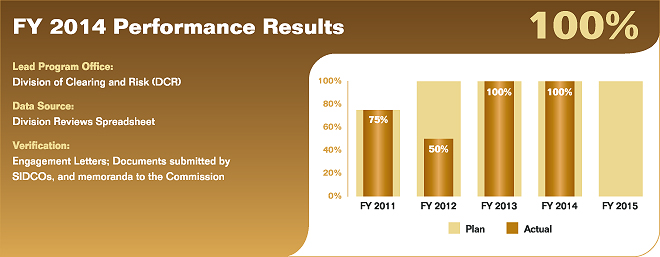
Performance Analysis & Review
The performance target was met for FY 2014. The Examinations Group completed the annual examinations of those DCOs that have been designated, pursuant to Title VIII of the Dodd-Frank Act, as systemically important financial market infrastructures by the Financial Stability Oversight Council (FSOC) for which the CFTC is the Supervisory Agency (SIDCO). The Commission examined both SIDCOs during the year. The core principles selected for each examination were based upon a risk evaluation of each of the SIDCOs and the core principles selected included system safeguards, financial resources, risk management, governance fitness standards, conflicts of interest, and composition of governing boards. Multiple regulatory bodies participated in both examinations and the CFTC planned and coordinated all aspects of the examination process.
PERFORMANCE MEASURE 2.1.1.2 On a risk-based basis, review all other DCOs annually
to assess compliance with DCO core principles and Commission requirements.
FY 2014 Target: 100%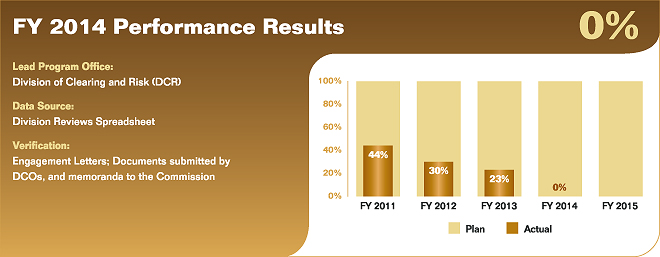
Performance Analysis & Review
The performance target was not met for FY 2014. The Commission was not able to meet this goal due to staffing limitations and the need to develop new examination programs to measure compliance with new regulations that became effective during the review period on liquidity risk management, risk management, and business continuity and disaster recovery plans and resources. In addition the Examinations Branch updated its examination program surrounding cyber security.
All DCOs submit quarterly filings to demonstrate compliance with the financial resource requirements. The CFTC received and analyzed 74 filings consisting of 50 quarterly filings, 12 monthly filings, and 12 certified filings during the performance period. In addition, the Examinations Branch received and analyzed 138 notice filings. Of those notifications, 50 pertained to hardware or software malfunction, cyber security incident, or targeted threat that materially impaired or created a significant likelihood of material impairment of automated systems and there was a need to review those filings promptly.
PERFORMANCE MEASURE 2.1.1.3 Percent of requests for Commission orders that are completed following review under the applicable provisions of the CEA.
FY 2014 Target: 96%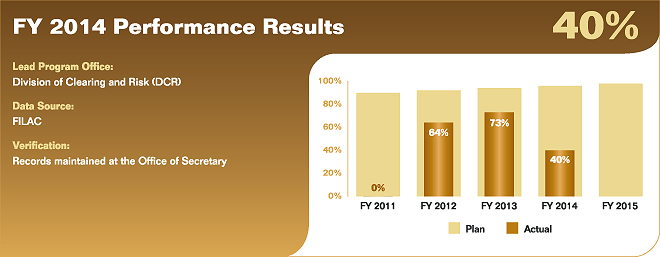
Performance Analysis & Review
The performance target was not met for FY 2014. The pending requests currently include: 1) a request from Southwest Power Pool, Inc. for an exemptive order under Section 4(c)(6) of the CEA; 2) a request from LCH.Clearnet, Ltd. for an amendment to its order of registration as a DCO that would permit it to provide clearing services for “swaps,” as defined in the CEA and Commission regulations, as well as all futures and options on futures; and 3) a request from ICE Clear Europe Limited for an order pursuant to Section 4d(a) of the CEA to revise its earlier order permitting portfolio margining of futures and foreign futures to expand the scope of the participants to include non-clearing FCMs. In FY 2014, the Commission issued an order to CME regarding the treatment of funds held in connection with the clearing of over-the-counter (OTC) wheat calendar swaps as well as an order to ICE Clear Europe Limited to permit commingling of customer funds in connection with futures and foreign futures contracts for products, including certain interest rate, energy, and financial contracts. For several of the requests, the Commission has completed substantial work but is waiting for further information from the requesters. In other cases, competing priorities mean that requests cannot be acted upon. Chief among the factors limiting progress is inadequate staffing. Risks of not achieving target include registrants not being able to implement business plans that would, if staff had resources to evaluate them, merit such orders. Conversely, the benefit of achieving the target is that registrants are able to implement merit-worthy business plans.
PERFORMANCE MEASURE 2.1.2.1 Applications are reviewed and a determination made regarding compliance with financial integrity provisions of the CEA within statutory time frames. Percent in compliance with financial integrity provisions.
FY 2014 Target: 100%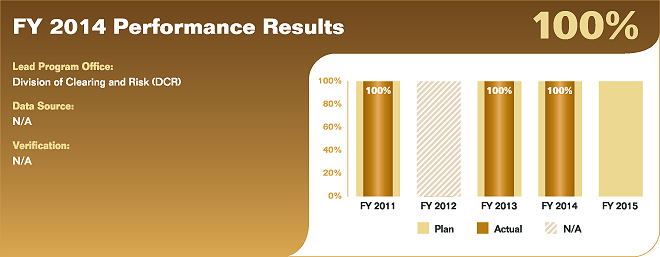
Performance Analysis & Review
The performance target was met for FY 2014. The Commission reviewed the DCM application of NASDAQ Futures, Inc., which was received in February 2014.
PERFORMANCE MEASURE 2.1.3.1 All material exceptions in monthly and annual financial filings
by FCMs and RFEDs and notices of noncompliance with respect to minimum capital and segregation
are reviewed and assessed within one business day. Percent completed within one business day.
FY 2014 Target: 100%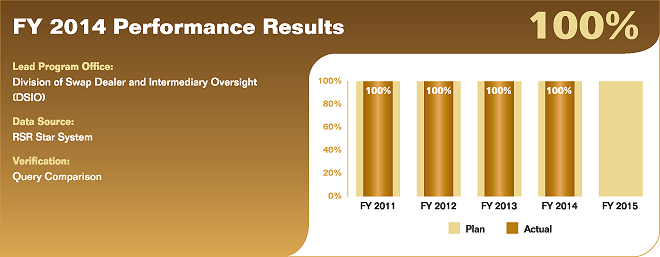
Performance Analysis & Review
The performance target was met for FY 2014. The Commission reviewed all 11 notices received within the targeted time of one business day. As appropriate, a follow up was performed with the filers and/or their designated self-regulatory organization (DSRO) to ensure that the fiscal integrity of the markets was maintained. Because segregated and secured funds are critical to the fiscal integrity of the market place and to customer financial protection, the ability to meet this target is vital to the Commission’s financial oversight mission.
PERFORMANCE MEASURE 2.1.3.2 On a risk-based basis, conduct direct examinations of FCMs
and RFEDs, identify deficiencies, and confirm that all deficiencies identified are corrected within
the specified period of time. Percent corrected within specified time period.
FY 2014 Target: 96%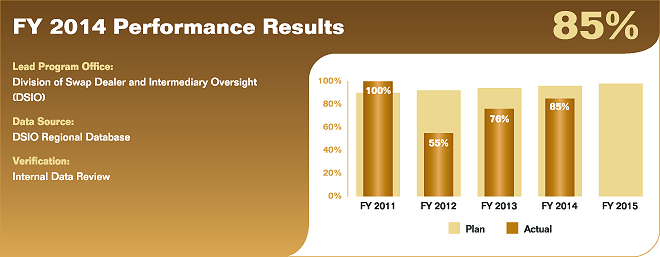
Performance Analysis & Review
The performance target was not met for FY 2014. Although the Commission had planned to conduct limited-scope, risk-based examinations comparable in number to what had been performed in FY 2013 (13), only 11 examinations were performed in FY 2014 due primarily to prolonged resource constraints and other mission priorities. However, for these examinations, all deficiencies identified were corrected within the specified time period. The examinations performed in FY 2014 were very limited reviews that were reactive to the market place. In addition, the scope of the reviews was further reduced to target areas of greatest risk to the market or to firm customers. Examples of high risk focus areas include risks unique to the firm (as identified through the Commission’s monitoring process) and, as in the case of a liquidity review, the aspects of a firm’s operations most likely to cause harm to customers or threaten market financial integrity. Since 2011, examination production (which exceeded 30 reviews) has dropped by nearly 65 percent (to the 11 reviews conducted in FY 2014). If not addressed, the Commission believes that operational capacity will be further eroded by the work demands of SD/MSP oversight which in FY 2015 will demand additional staff time now that the initial registration process for these new registrants is nearing conclusion.
PERFORMANCE MEASURE 2.1.4.1 Reviews of swaps submitted to the Commission are completed within statutory and regulatory deadlines.
FY 2014 Target: 100%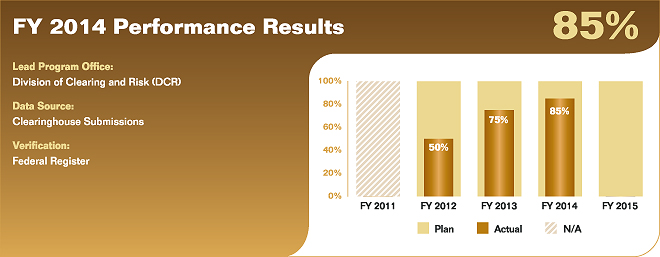
Performance Analysis & Review
The performance target was not met for FY 2014. Section 2(h) of the CEA requires the Commission to determine whether to mandate clearing for swaps submitted to the Commission by registered DCOs (pursuant to Section 2(h) of the CEA and Regulation 39.5(b)), within 90 days of the Commission’s receipt of any such submission. The Commission also must post the submission for public comment during the 90-day period. During FY 2014, the Commission received 10 such submissions from registered DCOs, and staff of the DCR reviewed all of the submissions. However, the Commission neither posted any of those submissions for public comment nor issued any determinations as to whether the swaps covered by those submissions should be subject to a clearing requirement. In addition, the Commission did not take action on open submissions that had been received in FY 2013.
PERFORMANCE MEASURE 2.1.5.1 Reviews of DCO rules submitted to the Commission
are completed within statutory and regulatory deadlines.
FY 2014 Target: 100%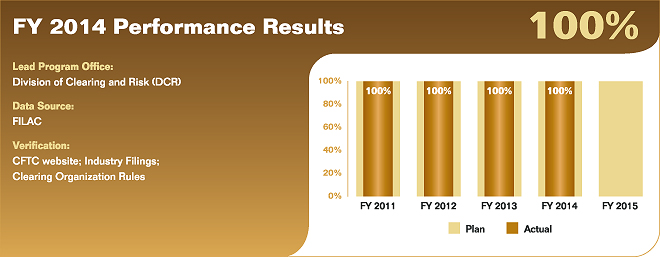
Performance Analysis & Review
The performance target was met for FY 2014. During FY 2014, 201 DCO rules were filed as self-certifications under Regulation 40.6 and seven rules were filed under Regulation 40.10, which requires that a SIDCO provide notice to the Commission not less than 60 days in advance of any proposed change to its rules, procedures, or operations that could materially affect the nature or level of risks presented by the SIDCO. Delays with respect to rules filed pursuant to Regulation 40.10 are, in part, due to inadequate information supplied by the registrant. In other cases, delays arose due to inadequate staffing. Risks of not achieving target include registrants not being able to implement rules that would, if staff had resources to evaluate them, merit prompt approval, or more prompt delineation of missing information. Conversely, the benefit of achieving the target is that registrants are able to implement merit-worthy rules, or more promptly learn of staff concerns with proposed rules.
PERFORMANCE MEASURE 2.1.6.1 Perform risk analysis and stress-testing on large trader and
clearing member positions to ascertain those with significant risk and confirm that such risks
are being appropriately managed. Number of positions analyzed.
FY 2014 Target: 650,000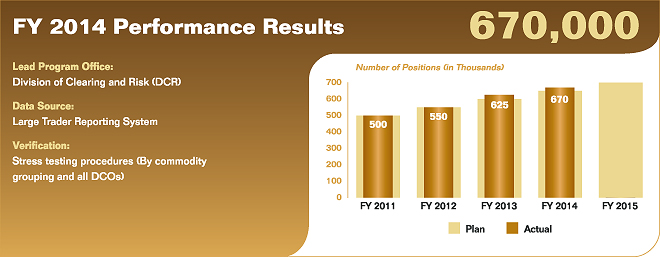
Performance Analysis & Review
The performance target was met for FY 2014. Risk surveillance tools have been enhanced to allow for more comprehensive stress testing. The Stressing Positions at Risk (SPARK) application has been greatly enhanced to allow for automated stress testing. Additionally, the Risk Surveillance Branch has developed credit default swap (CDS) and interest rate swap (IRS) risk surveillance capabilities.
Staff members conduct daily stress tests of energy, interest rate, equities, agricultural, soft agricultural, and metals account and firm positions. Stress tests are performed at a variety of levels (e.g., all time move and 150 percent of product margin requirements) and results are compared to a variety of metrics (e.g., excess net capital and margin on deposit). Stress tests are also performed across multiple commodity groups.
The CFTC conducted a wide variety of risk analysis on large trader and clearing member positions, relying primarily on the Integrated Surveillance System (ISS) and SPARK databases in conjunction with Standard Portfolio Analysis of Risk (SPAN®) Risk Manager Software. In addition, staff conducted financial analysis of clearing members using Regulatory Statement Review (RSR) Express. Through the use of these and other systems Commission staff members identify traders with the greatest overall market risk and those that pose a material risk to their clearing members.
PERFORMANCE MEASURE 2.1.6.2 On a risk-based basis, meet with large traders, FCMs, SDs,
and other industry participants to discuss risk management issues. Number of entities met with
and risk issues reviewed.
FY 2014 Target: 143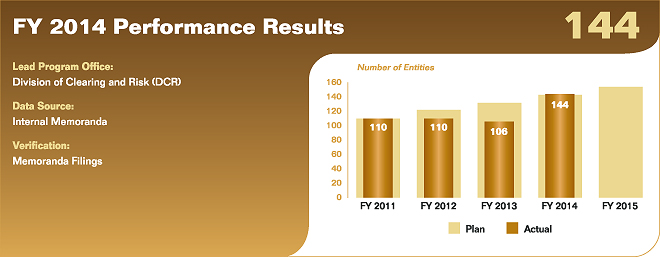
Performance Analysis & Review
The performance target was met for FY 2014. Travel funds were sufficient for staff to perform several New York and other out of state regulation 1.73 and trader risk reviews. Traders with large risk relative to the size of their clearing firm and traders with risk across multiple firms or DCOs were selected for risk reviews. Additionally, DCR staff were able to meet with risk management staff at several larger firms to discuss each specific firm’s risk across origins and DCOs.
In FY 2014, the Commission conducted the most Regulation 1.73 reviews in the brief history of the program. These reviews include review and evaluation of firm risk surveillance procedures and output. The reviews also involve observing and evaluating risk surveillance procedures.
-
Goal Two performance measures, analysis and review – Objective 2.2
PERFORMANCE MEASURE 2.2.1.1 Conduct direct examinations of swap dealers and major swap participants to identify deficiencies, and confirm that all deficiencies identified are corrected within specified period of time.
FY 2014 Target: 100%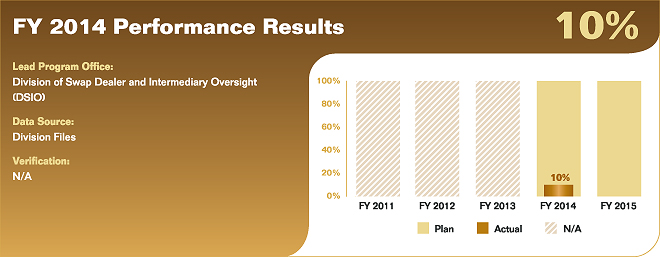
Performance Analysis & Review
The performance target was not met for FY 2014. Due to a continued lack of necessary staffing resources, no SD/MSP reviews were planned in FY 2014. However, the Commission was required to perform one SD exam in direct response to a significant trading issue. This SD exam resulted in the deficiencies being corrected by the firm within the specified time period. Since the Commission has no base examination resources to conduct SD/MSP reviews, performing this review came at the expense of other priority areas, further impacting the CFTC’s ability to meet examination performance targets.
PERFORMANCE MEASURE 2.2.2.1 Under a risk-based approach, conduct reviews of selected
programs of all RFAs to assess fulfillment of statutory and delegated responsibilities and confirm
that any deficiencies identified are corrected within the specified period of time. Percent of
deficiencies corrected within specified time period.
FY 2014 Target: 96%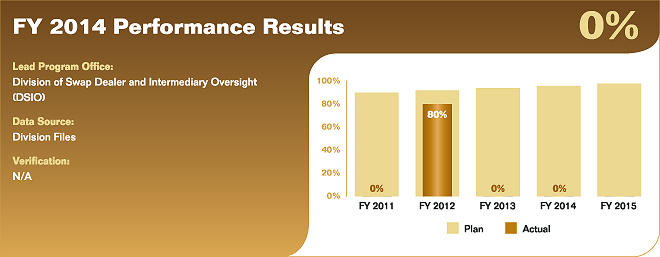
Performance Analysis & Review
The performance target was not met for FY 2014. The workload demands of the Dodd-Frank Act rule implementation in combination with resource constraints resulted in the inability to conduct reviews of registered futures associations (RFAs). The lack of RFA program reviews by the Commission may result in deficiencies going uncorrected and impairment of the Commission’s regulatory mission. The Commission plans to continue its work to identify staffing efficiencies and explore other alternatives to identify the dedicated resources necessary to complete this measure.
PERFORMANCE MEASURE 2.2.2.2 Percentage of RFA rules submitted for which determinations
are made within statutory time frames.
FY 2014 Target: 96%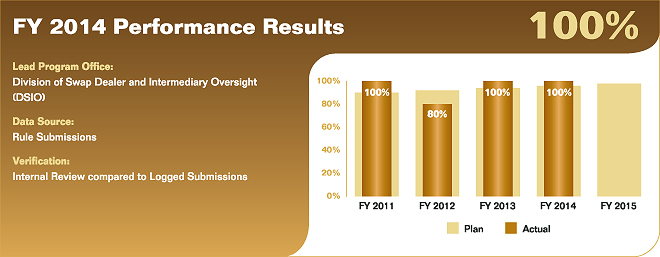
Performance Analysis & Review
The performance target was met for FY 2014. All RFA rules submitted were evaluated and appropriate determinations were completed within the time allowance required by the measure. Examples of RFA rules evaluated during the performance year included National Futures Association (NFA): Submission of Swap Dealer and Major Swap Participant Filings Through WinJammer™—NFA Compliance Rule 2-49 Regarding Swap Dealers and Major Swap Participants Regulations and NFA: Decrease in Membership Dues for Major Swap Participants—NFA Bylaw 1301 Regarding Schedule of Dues and Assessments.
PERFORMANCE MEASURE 2.2.3.1 On a risk-based basis, conduct direct examinations of non-FCM intermediaries, identify deficiencies, and confirm that any deficiencies identified are corrected within the specified period of time. Percent of time that deficiencies are corrected within specified time period.
FY 2014 Target: 96%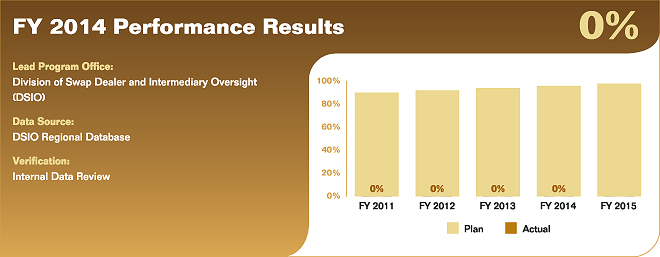
Performance Analysis & Review
The performance target was not met for FY 2014. The Commission chose not to review any non-FCM intermediaries in favor of relying on NFA to perform such examinations given limited resources and the ongoing need to prioritize tasks based on overall importance to the financial markets, customer protection, and other factors. As the new SD/MSP registration process continues, there will be an even greater need to balance and prioritize the allocation of staff resources moving forward.
-
Goal Two performance measures, analysis and review – Objective 2.3
PERFORMANCE MEASURE 2.3.1.1 On a risk-based basis, review all SROs annually to assess compliance with CEA and Commission requirements, identify deficiencies, and confirm that any deficiencies identified are corrected within the specified period of time. Percent of time in which deficiencies are corrected within specified time period.
FY 2014 Target: 96%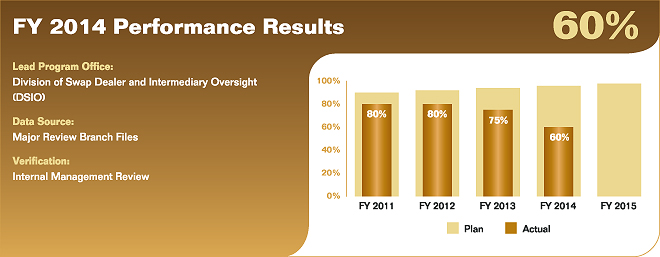
Performance Analysis & Review
The performance target was not met in FY 2014. The Commission reviews self-regulatory organizations (SROs) to assess compliance with the CEA and Commission requirements. Due to resource constraints, only six out of the 10 (60 percent) planned reviews were completed and none of the draft reports were submitted to the affected SROs in final form. Nevertheless, all reviews were completed in a thorough and timely manner and any significant issues or findings were communicated to the SRO immediately. As budgetary and staffing constraints continue, the Commission will maintain its efforts to seek innovative ways to complete and finalize these reviews.
PERFORMANCE MEASURE 2.3.1.2 Percentage of direct examinations of registered intermediaries
that confirm proper execution of SRO programs.
FY 2014 Target: 96%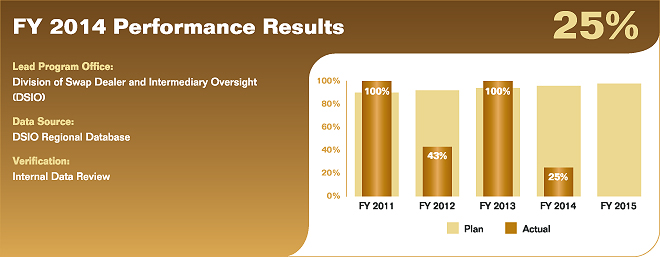
Performance Analysis & Review
The performance target was not met in FY 2014. Due to a continued decline in available examination staff caused by attrition and initial budget constraints and the operational need to allocate limited resources to address other critical priorities, the Commission completed only five of the 20 limited scope reviews. Nevertheless, the CFTC maintained ongoing dialogue with the SROs throughout the fiscal year on examinations issues.
-
Goal Two performance measures, analysis and review – Objective 2.4
PERFORMANCE MEASURE 2.4.1.1 Program redesign to cover new registrants monitored
by the RSR and SPARK systems. Percentage of system redesign accomplished.
FY 2014 Target: 98%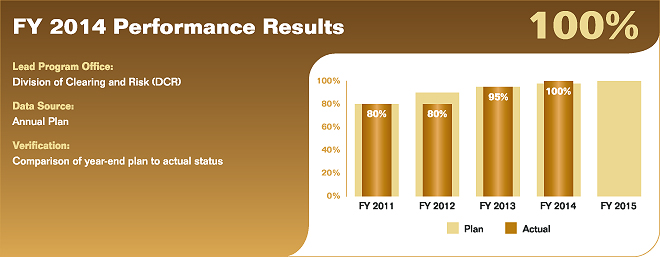
Performance Analysis & Review
The performance target was met for FY 2014. All planned enhancements to the SPARK application have been made in the past year. Stress testing capabilities have been greatly enhanced. Search capabilities have also been enhanced. Part 39 query capabilities have been added to the application. The RSR application has been updated to accept DCO filings.
The Commission conducted risk surveillance activities through the use of automated financial and risk surveillance systems and applications such as RSR Express and SPARK databases. Staff members use RSR Express to receive and review monthly FCMs financial statements; and SPARK to identify volatile markets, firms that have positions on the losing side of the market, and customers at the identified firms. Large trader positions are downloaded into an application that allows for the margining and stress testing of positions. Both RSR Express and SPARK applications were developed in-house.
PERFORMANCE MEASURE 2.4.1.2 Program design to cover new data collection requirements
to monitor systemic risk posed by CPOs and CTAs advising private funds, and new registration
of swap dealers. Percentage of system design accomplished.
FY 2014 Target: 98%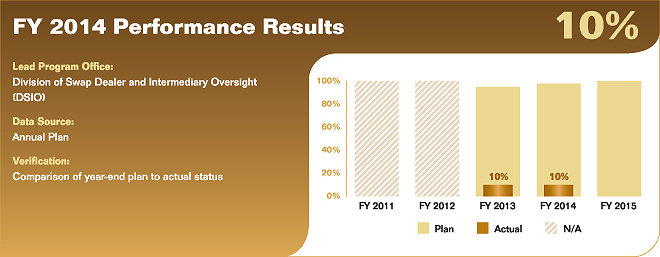
Performance Analysis & Review
The performance target was not met in FY 2014. Although an initial framework regarding the use of CPO/CTA data is in place, the CFTC’s goal to provide this data to the FSOC regarding systemic risk and to participate in the IOSCO hedge fund survey continues to be negatively impacted by resource constraints. Moving forward, the Commission will seek to identify resource solutions and efficiencies to continue progress on this mission critical goal.
-
-
-
Goal Three—Protect the public and market participants through a robust enforcement program.
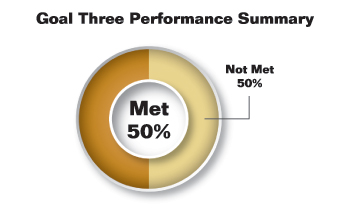
The Commission is committed to prosecuting violations of the CEA and Commission regulations to protect market participants and promote market and financial integrity. The DOE investigation and litigation matters are broadly categorized into four areas: 1) manipulation, 2) trade practice,3 3) fraud, and 4) supervision and control. The CFTC filed 67 enforcement actions in FY 2014 and obtained $3.27 billion in sanctions that includes more than $1.8 billion in civil monetary penalties (CMPs) and more than $1.4 billion in restitution and disgorgement. This brings the Commission’s total monetary sanctions over the past two fiscal years to more than $6 billion, which is more than the total sanctions imposed during the prior 10 fiscal years combined. In addition, the Commission:
- Continued to investigate whether certain banks and interdealer brokers have manipulated or attempted to manipulate or made false reports concerning global benchmark interest rates, including the London Interbank Offered Rate (LIBOR). To date, the Commission has filed and settled seven actions, against Barclays, UBS, RBS, Rabobank, Lloyds, RP Martin and ICAP imposing penalties of nearly $1.9 billion. This matter is being investigated in coordination with several other domestic and foreign regulators and agencies.
- Filed and settled a landmark case against JP Morgan Chase Bank, N.A., arising out of London Whale trading and charging, for the first time, the reckless use of a manipulative device in violation of new Dodd-Frank Act anti-manipulation authority. The Commission’s order found that by selling a staggering volume of credit default swaps (CDSs) in a concentrated period, JP Morgan recklessly disregarded the fundamental precept that prices are to be established based on legitimate forces of supply and demand. JP Morgan was ordered to pay a $100 million penalty and to strengthen internal controls.
- Resolved litigation against Eric Moncada and proprietary trading firms BES Capital LLC (BES) and Serdika LLC (Serdika), on charges of attempted manipulation through “spoofing” orders, fictitious and non-competitive transactions in the wheat futures market. The court granted a summary judgment on the charges of fictitious sales and non-competitive transactions, in addition to a permanent trading and registration ban. Per the consent Order, Moncada attempted to manipulate the wheat futures market by entering and cancelling large lot orders without the intent to fill the orders. Defendants were ordered to pay a penalty of $1.56 million.
- Resolved litigation against Parnon Energy Inc., Arcadia Petroleum Ltd, and others for crude oil manipulation. Defendants ordered to pay $13 million in CMPs and subject to limits on physical market trading.
- Filed and settled charges that Sean R. Stropp made false and misleading statements of material fact and omitted material facts to the Commission during an investigation. Specifically, Stropp provided the Commission a signed and notarized financial disclosure statement that omitted material facts, including both under his control of, and his spouse’s ownership interest in, another entity selling leveraged metals contracts.
- Won a liability verdict after trial against a major off-exchange metals company on fraud charges in connection with financed transactions in precious metals that resulted in millions of dollars in customer losses. The court found that over 90 percent of Hunter Wise Commodities, LLC’s retail customers lost money, and Hunter Wise and its two principal owners had knowingly defrauded more than 3,200 retail customers. Earlier in the fiscal year, the CFTC won a summary judgment on charges that the defendants’ transactions violated the Dodd-Frank Act’s new provisions requiring this type of transaction to be executed on exchange. Along with the other precious metals cases, this action was a prime example of how the Commission is using its new authority under the Dodd-Frank Act to pursue wrong-doers who prey on investors looking to make investments in commodities like gold and silver.
Goal Three performance measure results are depicted in the following table:
Goal Three Performance Results # of Measures4 Met Not Met Goal Three 2 1 1 % of Total 50% 50%
3 Trade practice violations generally include disruptive trading, spoofing, wash sales, and other activities that interfere with the competitive trading of exchange-traded contracts. (back to text)
4 Excludes one performance measure categorized as “Not Applicable” for FY 2014. (back to text)
-
Goal Three performance measures, analysis and review – Objective 3.1
PERFORMANCE MEASURE 3.1.1.1 Percentage of enforcement investigations concluded within
one year of opening.
FY 2014 Target: 75%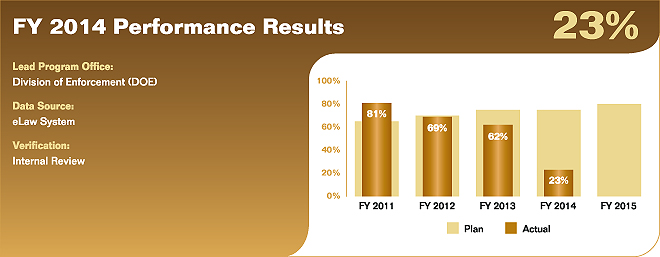
Performance Analysis & Review
The performance target was not met for FY 2014. The Commission was unable to meet the performance level of 75 percent for this goal. In FY 2014, the DOE opened 244 investigations, and of those, was able to close 57 investigations. This reflects the increased volume of high-level complex investigations requiring more evidentiary support and analysis to bring cases forth without having the necessary level of resources to support concluding complex matters within a 12-month period. In the FY 2014–2018 Strategic Plan, the Commission is shifting the target to 18 months instead of 12 months to produce realistic results in the current fiscal environment and complex nature of investigations. After examining the impact of the increased amount of investigations that has significantly constrained the Commission’s limited time and resources, the 18-month target should be more attainable. The Commission will consider revising this performance measure to make it a more effective measure of timely and efficient investigations.
-
Goal Three performance measures, analysis and review – Objective 3.2
PERFORMANCE MEASURE 3.2.1.1 Percentage of CFTC case filings that include referrals to domestic civil and criminal cooperative authorities.
FY 2014 Target: 75%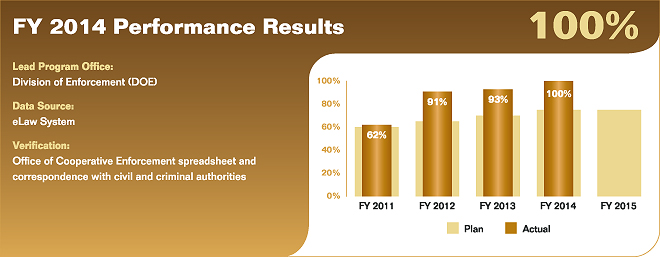
Performance Analysis & Review
The performance target was met for FY 2014. During the period October 1, 2013 through September 30, 2014, there were 57 enforcement actions filed. There were 37 actions that were not referred to other agencies because the nature of the violations, registration, supervision, position limits, off-exchange transaction, and segregation did not support criminal prosecution. The remaining 20 matters involved fraud and market manipulation, which have been areas of active criminal prosecution. All of these matters were the subject of cooperative enforcement referrals between the Commission and other agencies. The Commission referred some of these matters to other agencies and some of these matters were referred to the Commission in connection with a prior ongoing investigation by another agency. This translates to a referral rate of 100 percent. The Commission will evaluate this performance measure to determine its effectiveness as the referral process is a discretionary process.
-
-
-
Goal Four—Enhance integrity of U.S. markets by engaging in cross-border cooperation, promoting strong international regulatory standards, and encouraging ongoing convergence of laws and regulation worldwide.
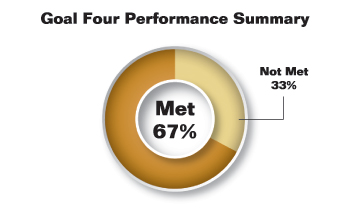
The implementation of comprehensive regulations under the Dodd-Frank Act legislation marks a new era in the swaps marketplace by mandating, among other things, the regulation of swap dealers (SDs), clearing of swaps, and transparency with respect to those transactions. However, regulation in the United States alone will not be sufficient to protect the global financial system. Because the swaps market is conducted on a global basis, it is possible for swaps executed offshore by U.S. financial institutions to transmit the risk of those transactions back to the United States. This already has transpired with the offshore affiliates of AIG, Lehman Brothers, Citigroup, Bear Stearns, and Long Term Capital Management, and most recently, when JPMorgan Chase executed swaps through its London branch.
Recognizing this risk, the United States joined with other G-20 leaders in 2009 to require that all major market jurisdictions bring swaps under regulation. Since that date, the Commission has been engaged in an unprecedented outreach to major market jurisdictions and expanded involvement in numerous international working groups to encourage the adoption of robust swaps regulation.
This added emphasis on swap market regulation supplements the Commission’s long-standing engagement with foreign regulators to establish and enforce customer and market protection arrangements in derivatives trading, including the Commission’s participation in the IOSCO Multilateral Memorandum of Understanding (MOU), which enables the Commission to obtain cooperation from approximately 100 foreign regulators in enforcement matters. The Commission’s recent successes in bringing LIBOR actions involved valuable assistance from the Commission’s cooperative relationships with its counterpart foreign regulators which aided its ability to obtain evidence of the widespread wrongdoing. The Commission also remains committed to taking a strong role in international standard-setting organizations such as IOSCO, which recently recognized the Commission’s long history of contributions by voting to make the Commission a full member.
CFTC also provides technical assistance to emerging and recently-emerged markets to help these jurisdictions in establishing and implementing laws and regulations that foster global market integrity. The Commission’s international training symposium has consistently attracted wide attendance by foreign regulators who look to the Commission as a global standard setter in derivatives regulation.
Accomplishments related to progress in achieving this goal include:
- Continued its important work on substituted compliance, completing eight internal assessments and recommendations for Commission leadership regarding whether the laws and regulations of certain foreign jurisdictions were comparable to and as comprehensive as those administered by the Commission with respect to the oversight of foreign SDs and foreign major swap participants (MSPs). In December 2013, the CFTC issued substituted compliance determinations for SDs and MSPs in Australia, Canada, the European Union (EU), Hong Kong, Japan, and Switzerland with respect to certain entity level requirements. At the same time, the CFTC issued substituted compliance determinations for the EU and Japan with respect to certain transaction-level requirements. The Commission was approached by a number of additional foreign jurisdictions seeking comparability determinations and it is considering those applications.
- Set forth an alternative to Swap Execution Facility (SEF) registration for EU-regulated multilateral trading facilities (MTFs) that are subject to regulation that is comparable to CFTC requirements. Persons executing swaps on such qualifying MTFs would satisfy the CFTC’s trade execution mandate. In May 2014, the CFTC extended a previous grant of relief to an Australian trading venue.
- Worked with the Aggregation Feasibility Study Group (AFSG) formed by the Committee on Payments and Market Infrastructures (CPMI)/ International Organization of Securities Commissions (IOSCO) to analyze options for aggregating trade repository data such that regulators and authorities could fulfill their respective mandates while supporting the financial stability of the markets. The CFTC responded to this call by accepting IOSCO’s request to co-chair the AFSG, along with the European Central Bank as the co-chair representing the CPMI. On September 19, 2014, the Financial Stability Board (FSB) published the final report of the AFSG and approved the undertaking of the recommended key steps described in the final report. The CFTC is taking a leadership role in the organization and forthcoming execution of the following recommended key steps:
- The development and implementation of a uniform global unique transaction identifier and unique product identifier;
- The development of global guidance on the harmonization of data elements reported to trade repositories that are important for authorities to aggregate in order to fulfill their respective mandates and support the financial stability of the markets; and
- The study of the legal and regulatory changes that would be needed to implement a global aggregation mechanism, and an appropriate related governance structure.
- Worked with the Policy Standing Group (PSG) formed by CPMI/IOSCO to address standards for market infrastructures. The CFTC responded to this call by accepting IOSCO’s request to co-chair the PSG, along with the European Central Bank as the co-chair representing the CPMI.
- Worked with international authorities with responsibility for the regulation of the over-the-counter (OTC) derivatives markets in major market jurisdictions to support the adoption and enforcement of rigorous and consistent standards, develop concrete and practical solutions to conflicting application of rules, and identify inconsistent or duplicative requirements.
- Worked throughout the year with foreign authorities, including the European Commission, European Securities Market Authority, and other foreign regulators to coordinate policies that will be needed to implement final Commission Dodd-Frank rules for market infrastructure and participants (e.g., with regard to swap data repositories (SDRs), SDs, derivatives clearing organizations (DCOs), and SEFs).
- Continued to enhance its cooperation with foreign regulators in the supervision of regulated entities by signing several supervisory cooperative arrangements and continuing negotiations with respect to pending arrangements. The Commission also continued its long-standing practice of cooperating with foreign regulators in an enforcement context.
- Trained over 50 foreign regulators at its international training symposium to assist in establishing and implementing laws and regulations that minimize the likelihood of regulatory arbitrage and promote cross-border enforcement and supervisory assistance.
Goal Four performance measure results are depicted in the following table:
Goal Four Performance Results # of Measures5 Met Not Met Goal Four 3 2 1 % of Total 67% 33% 5 Excludes one performance measure categorized as “Not Applicable” for FY 2014. (back to text) -
Goal Four performance measures, analysis and review – Objective 4.1
PERFORMANCE MEASURE 4.1.1.1 Days allotted for acknowledgment of incoming requests for enforcement assistance from our international counterparts pursuant to our information sharing arrangements.
FY 2014 Target: 2 Days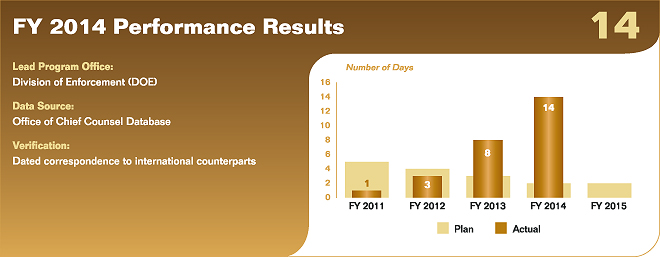
Performance Analysis & Review
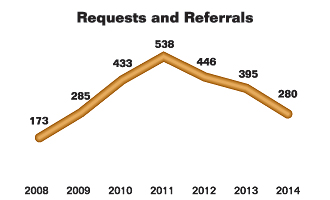
The performance target was not met for FY 2014. The Commission received more information requests and leads from international counterparties regarding assistance on investigations than the DOE could support given its current resources. The Commission will reevaluate this performance measure to determine whether there is a better approach to measuring the effectiveness and timeliness of processing international requests, particularly given that the Commission’s international collaboration efforts are expected to increase significantly in the foreseeable future.
-
Goal Four performance measures, analysis and review – Objective 4.2
PERFORMANCE MEASURE 4.2.1.1 Number of international regulatory and standard-setting working groups in which the Commission participates.
FY 2014 Target: 9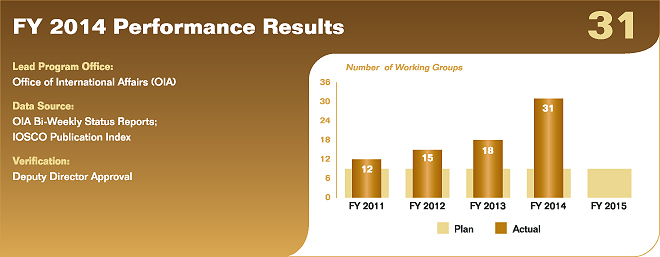
Performance Analysis & Review
The performance target was met for FY 2014. The CFTC participated in 31 international working groups. The increase is attributed to CFTC-wide participation in international groups. The CFTC is actively communicating internationally, to promote robust and consistent standards, avoid conflicting requirements, and to engage in cooperative supervision where possible. While much of the CFTC’s international representation continues to be within the IOSCO, it is noteworthy that the CFTC’s work in other fora, such as the FSB and various other groups continues to increase. In addition to IOSCO, many of the Commission’s recent international representation efforts involves work streams outside of IOSCO, particularly as it relates to work on harmonizing international OTC policies.
-
Goal Four performance measures, analysis and review – Objective 4.3
PERFORMANCE MEASURE 4.3.1.1 Number of non-U.S. regulators trained.
FY 2014 Target: 225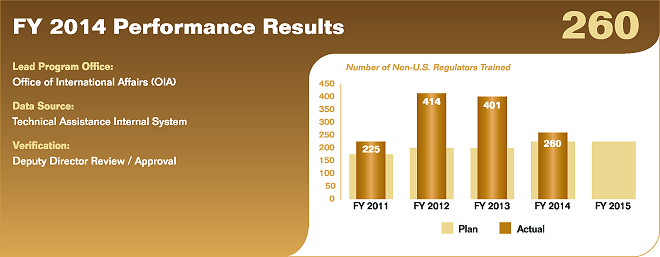
Performance Analysis & Review
The performance target was met for FY 2014. OIA and CFTC staff provided technical assistance to approximately 260 staff from non-U.S. regulators. The CFTC coordinates a variety of technical assistance activities: visits by foreign regulators for discussions with Commission staff on a variety of technical regulatory matters, on-site missions by Commission staff to share regulatory approaches with foreign regulators and market authorities, and the annual symposium and training seminar for foreign regulators.
-
-
-
Goal Five—Promote Commmmission excellence through executive directction and leadership, organizational and individual performance management, and effectctive management of resources.
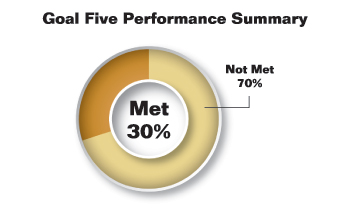
Strategic Goal Five addresses those areas that enable the Commission to execute its mission of protecting market users and the public from fraud, manipulation, and abusive practices. Excellence in this area is reflected in strong and focused planning and governance, top notch information technology (IT) and infrastructure, sufficient facilities, efficient execution of resources, and an educated and productive workforce. The key results summarize CFTC’s mission support strategy.
- Continued to promote diversity and inclusion throughout CFTC; three charters with internal affinity organizations (Association of Asian Americans and Pacific Islanders, Hispanic-Latino Employee Association, and Association of African Americans) were established in FY 2014. These affinity groups sponsored five brown bag lunches to promote professional development and four outreach activities to promote CFTC careers among target populations.
- Held 52 internal training opportunities across a wide range of technical and leadership topics. In addition, the Commission enhanced or established a number of desktop learning tools that can be accessed by employees at any location at their convenience. For example, in February 2014, the CFTC secured a contract with the Practicing Law Institute that allows all CFTC staff to have access to its in-person conference and online learning library.
- Broadened the privacy threshold analysis process to alert the program leaders about anticipated data collections, new technologies, or changes to technology that may raise information governance risks, e.g., privacy, records, e-discovery, Freedom of Information Act (FOIA), legal or human resources risks. This new “InfoGov Questionnaire” process is working well, and the Information Governance program leaders have provided feedback on over a dozen projects to minimize the risk to the CFTC.
- Upgraded its core financial system in FY 2014. The upgrade provides for stronger validation rules, improved functionality, and improved system integration. The result is better oversight and safeguard of taxpayer resources and improved accountability.
- Implemented position limit monitoring tools, which monitor positions held by trader groups across commodity groups and help in identifying groups who may be in violation of Federal exchange position limits.
- Expanded CFTC Portal capabilities to allow product and rule submissions as well as other information required by newly-implemented rules to be received electronically and automatically update Commission systems. Electronic reporting of structured data from industry required by the Dodd-Frank Act rules, including Volcker rule data, legal entity identifier (LEI) data, interim swap data repositories (SDR) data, and clearing data was implemented. The Commission began sharing data related to energy derivative trading with the Federal Energy Regulatory Commission (FERC), allowing the FERC to enhance its monitoring of energy markets.
- Improved mobile computing and mobile communications for staff by completing a mobile technology refresh.
- Piloted and implemented a high-performance computing platform. This platform will give staff the ability to perform analysis of high frequency trading and other data-intensive market activities.
- Successfully completed all planned FY 2014 business continuity test activities.
- Audio analytics enhancements provided enforcement staff with expanded metadata searching capabilities, expanded file tagging capabilities, and more efficient file handling.
- Completed the integration of Swaps (Part 20) data with futures Integrated Surveillance System (ISS) data, which provides CFTC staff with the ability to review combined positions and more accurately analyze aggregate risk.
- Improved the quality and consistency of swaps and derivatives, which significantly increased its utility in market surveillance activities. In addition, the phased harmonization of data across multiple SDRs is being executed by the CFTC, industry participants, and other regulators. The Swaps and Derivatives Database collects and maintains data and assists CFTC staff as they monitor derivatives markets. The Swaps and Derivatives Database houses daily swaps position data that is analyzed by staff in concert with large trader position data and trade surveillance data.
Goal Five performance measure results are depicted in the following table:
Goal Five Performance Results # of Measures Met Not Met Goal Five 10 3 7 % of Total 30% 70% -
Goal Five performance measures, analysis and review – Objective 5.2
PERFORMANCE MEASURE 5.2.1.1 Develop, adopt, and implement a comprehensive planning process.
FY 2014 Target: Refine usage of BPAC and automated time and attendance system.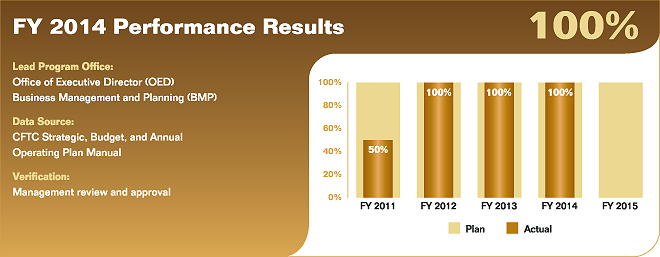
Performance Analysis & Review
The performance target was met for FY 2014. Based on a thorough review of all FY 2014 transactions through September 30 2014, a valid, non-default (i.e., all zeroes) Budget Program Activity Code (BPAC) code was used on 99.95 percent of transactions. The majority of transactions that did not contain a valid BPAC code were either credit card charges or payments to individuals. In order to reduce these transactions, the Commission will continue to coordinate with Procurement and the business managers to ensure valid BPAC codes are used on all transactions.
-
Goal Five performance measures, analysis and review – Objective 5.3
PERFORMANCE MEASURE 5.3.1.2 Improve time to hire from 150 days to 80 days.
FY 2014 Target: Improve time to hire by 10% in each of the next two years—saving 11 days.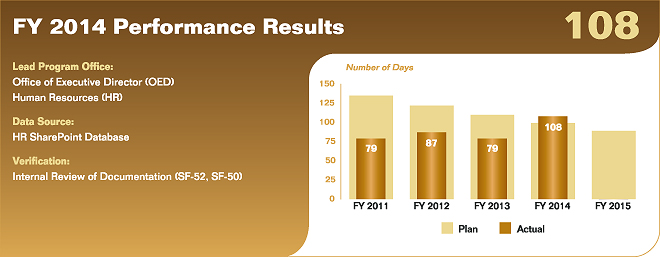
Performance Analysis & Review
The performance target was not met for FY 2014. The Commission met the Office of Personnel Management (OPM) 80-day requirement in the first and second quarters of FY 2014. However, once the Commission received its appropriations and initiated CFTC’s hiring plan in March 2014, the time-to-hire average for the FY 2014 hiring cycle increased by 28 days from FY 2013 and is now 108 days. The Entry on Duty average covers 125 cases (66 internal selections and 58 external actions). The longer timeframe was attributed to an increase in time spent in the security check process following the tentative offer of selection to the candidate. The security process has increased by as much as four to five weeks following the termination of one of OPM’s major contracting firms tasked with conducting security checks.
PERFORMANCE MEASURE 5.3.2.1 The CFTC is consistently rated by its employees as a small
agency workplace of choice and listed annually as one of the top 10 best places to work in the
Federal government (small agency category). The CFTC identifies low scores determined to be
of most significance to the Commission year over year to inform its improvement plans.
FY 2014 Target: Top 10 rating. Incorporate survey information into human capital strategic planning.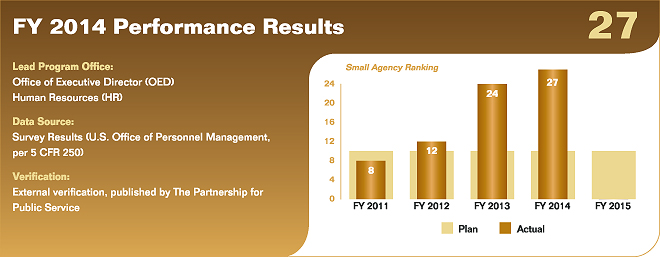
Performance Analysis & Review
The performance target was not met for FY 2014. The Federal Employee Viewpoint Survey (EVS) information has been incorporated into human capital strategic planning in the 2014–2015 Human Capital Plan in order to improve employee engagement and satisfaction to recapture ranking as a small agency of choice. Action items have been established to address areas of improvement identified from the 2013 EVS. Leadership has been briefed on the results of the 2013 EVS and the 2013 Listening Sessions. Performance goals for achieving improvement on the EVS cover planned activities in performance management/pay reform and work life flexibilities (e.g., work schedules, telework). Specifically, the CFTC has developed updated work schedules and telework policies and they are currently in review. In addition, in October 2014, the CFTC implemented a pre-tax parking program and increased the transit subsidy program benefit for employees. Implementation plans for performance management and pay reform will be launched in the near future. Thus far, the CFTC implemented a one-time 1 percent general pay adjustment retroactive to January 12, 2014, for all CFTC employees and increased the merit pay factor from 1 percent to 3.4 percent for the 2014 merit pay pools. Finally, the CFTC recently received results of the 2014 EVS and is in the process of reviewing the data. More information on the ratings of the CFTC can be found on The Best Places to Work in the Federal government website, http://bestplacestowork.org/BPTW/index.php.
PERFORMANCE MEASURE 5.3.3.2 Assess requirements, design, and implement a comprehensive
CFTC-wide mentoring program focused on enhancing the competencies of CFTC’s current and
future workforce.
FY 2014 Target: Survey and compile feedback on mentoring program. Develop program improvement plan based on feedback.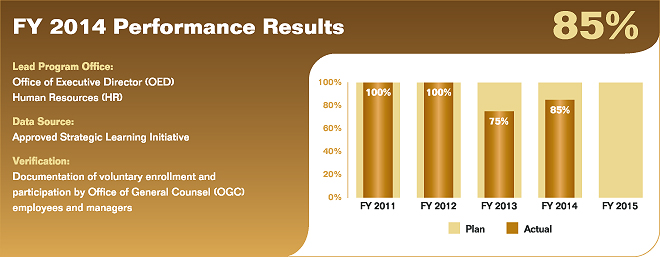
Performance Analysis & Review
The performance target was not met for FY 2014. The Commission continues to enhance its Mentoring Program. Though it was anticipated that a more technology focused design would be completed by the end of FY 2014, the programmatic enhancements that were identified have most recently moved from a design to testing phase. The design now incorporates suggestions made by senior leadership and data obtained through surveys and informal feedback that speak to: a searchable online biography library; automated workflow responses, online application and advanced mentor/mentee selection assistance. The enhanced tool will ensure a more precise match between mentors and mentees. The mentoring program will be fully implemented post the testing phase of the new mentoring program administrative tool. Anticipated deployment is scheduled for third quarter 2015.
-
Goal Five performance measures, analysis and review – Objective 5.4
PERFORMANCE MEASURE 5.4.1.1 Transparency and process maturity of IT governance
for reinforcing business unit and IT partnership.
FY 2014 Establishment and sustainment of enterprise target architecture and transition strategy.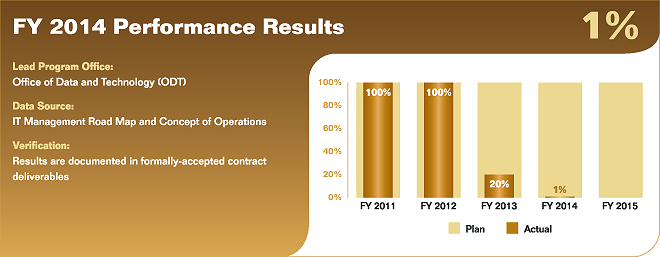
Performance Analysis & Review
The performance target was not met for FY 2014. Due to lack of funding, activity has been limited to establishing an as-is data catalog. The as-is data catalog will be published on CFTCnet to describe CFTC data and its access including classifications of data (e.g., PII or Section 8 data); how to find and/or access data; increase awareness of data collected and developed by the Commission; support subsequent information governance initiatives that depend on consistent and up-to-date categorization of data; support the implementation of data loss prevention tools to reduce risk of inadvertent or unauthorized data disclosures; and establish an enterprise architecture tool framework. In the absence of a fully-resourced enterprise architecture program, the Commission relies on the CFTC Strategic Plan and the CFTC IT Strategic Plan to guide investments.
PERFORMANCE MEASURE 5.4.1.2 Implementation of IT strategy and architecture for business continuity.
FY 2014 Target: Test Business Continuity Operational Headquarters Failover to the collocation facility.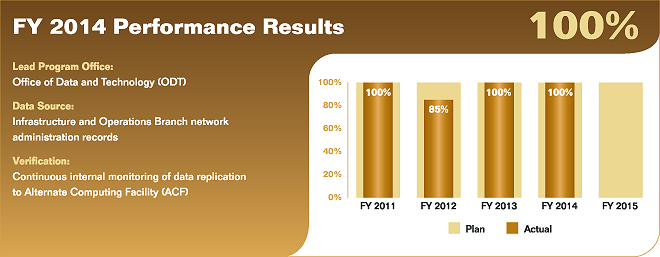
Performance Analysis & Review
The performance target was met for FY 2014. All planned FY 2014 test activities were completed successfully. IT Business Continuity support will continue to be sustained and enhanced.
PERFORMANCE MEASURE 5.4.2.1 Implementation of enterprise data management for effective aggregation, correlation with external data, and increased collaboration with other regulators.
FY 2014 Target: Integrate Integrated Surveillance System (ISS) into enterprise data warehouse.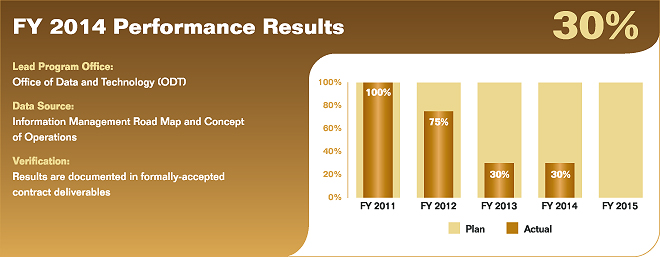
Performance Analysis & Review
The performance target was not met for FY 2014. The integration of swaps (Part 20) data with futures (ISS) data has been completed; however, a lack of funding has significantly slowed efforts toward an enterprise data warehouse. The swaps and derivatives database collects and maintains data and assists CFTC staff as they monitor derivatives markets. The database houses daily swaps position data that is analyzed by staff in concert with large trader position data and trade surveillance data. Early in FY 2014, the DMO finalized the Ownership Control Reporting (OCR) rule which will enable the integration of more datasets and the ultimate goal of a data warehouse, but implementation of the OCR rule will not be completed until February 2016. The first portion of the OCR rule is scheduled to be completed in February 2015 (Forms 102a and 102s) and the implementation of Forms 40 and 71 will be completed in February 2016. After the completion of the OCR rule implementation the data warehousing effort will resume.
PERFORMANCE MEASURE 5.4.2.2 Direct Access to SROs and SDRs for effective oversight.
FY 2014 Target: Integrate swaps data pushed from existing SDRs with existing systems.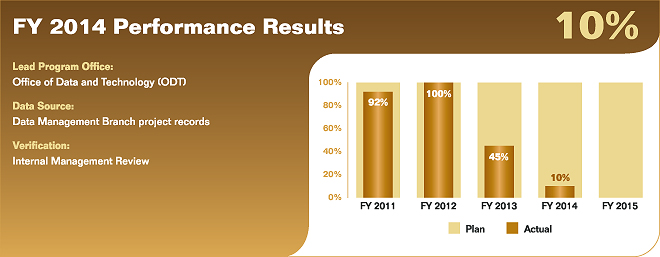
Performance Analysis & Review
The performance target was not met for FY 2014. The completion of SDR data harmonization work is essential to the integration of swaps data with the existing system. Due to resource constraints in the Commission, as well as the fact that achievement of the target depends on actions of many independent private parties, a phased harmonization of data across multiple SDRs is being executed. Sufficient notice has to be given to the SDRs to make changes to their systems to adhere to consistent form and manner that the Commission would prescribe. The harmonization of 25 data elements (Phase 1) for credit default swap (CDS) has been completed, and other phases for CDS have been started. Additionally, interest rate swap (IRS) data element harmonization has been initiated.
PERFORMANCE MEASURE 5.4.3.1 CFTC-wide document and records management and intranet solutions for improved data security collaboration, retention, sharing, and disposal.
FY 2014 Target: Implement enhancements to Case Management software. Implement enhancements to audio analytics. Implement ERDM workflow and version control (5 additional process groups).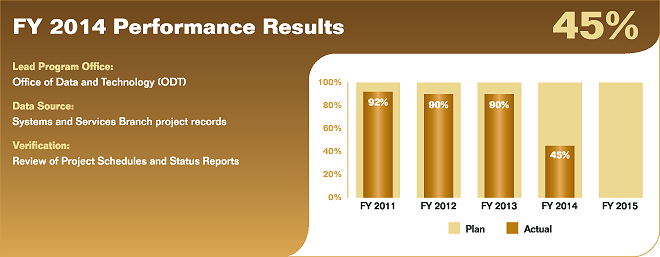
Performance Analysis & Review
The performance target was not met for FY 2014. Plans to purchase a new case management system to replace Practice Manager have been delayed because of a lack of funding. The Commission currently plans on purchasing new case management software in FY 2015. In early FY 2014, the Commission updated the audio file search and retrieval software, Nexidia, from version 9 to version 10 in the production environment. This upgrade provides the DOE of Enforcement end users with expanded metadata searching capabilities and expanded file tagging capabilities. In addition, audio files that are loaded to Nexidia are handled by the software more efficiently resulting in smaller files. The smaller file size will thus require less network storage. Two of the five Electronic Records and Data Management (ERDM) process groups have been implemented (OPERA (Organizations, Products, Events, Rules, and Actions) and DCR Examinations Request Tracking); completion of the Change Control Board automated workflow processing will be completed in November 2014 and the two other planned projects were cancelled due to lack of funding.
-
Goal Five performance measures, analysis and review – Objective 5.5
PERFORMANCE MEASURE 5.5.1.1 Reengineer, improve, and implement CFTC’s Cost
Accounting Codes (BPAC).
FY 2014 Target: Staff using cost accounting codes properly with error rate documented at less than 1%.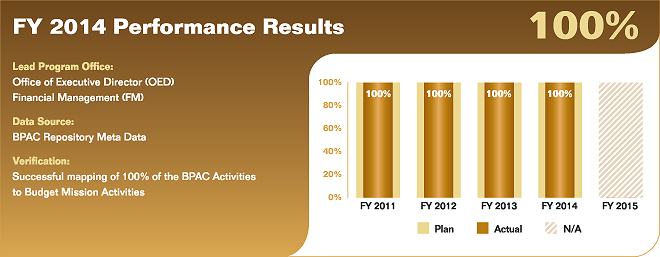
Performance Analysis & Review
The performance target was met for FY 2014. Based on a thorough review of all FY 2014 transactions through September 30, 2014, a valid, non-default (i.e., all zeroes) BPAC code was used on 99.95 percent of transactions. The majority of transactions that did not contain a valid BPAC code were either credit card charges or payments to individuals. In order to reduce these transactions, the Commission will continue to coordinate with Procurement and the business managers to ensure valid BPAC codes are used on all transactions.
-
Annual Performance Plan
FY 2016
Annual Performance Plan FY 2016 presents a tabular summary of objectives for Strategic Goals One-Four and Management Objectives. The following is provided for each objective: the overall target, timeframe, and description as well as FY 2015 and FY 2016 targets. See below for summaries by goal.
-
Goal 1: Market Integrity and Transparency
Objective 1.1: Markets not readily susceptible to manipulation and other abusive practices 1.1.a Strive for percentage of high impact contract and rule submissions received by the Commission through the OPERA portal. FY 2015
TargetFY 2016
TargetTarget Baseline in years 1-2 and set targets annually. Baseline TBD Timeframe 2018 Description Use of the OPERA portal will reduce staff burdens and increase the efficiency and effectiveness with which staff can strive to identify high impact contract and rule submissions in order to conduct reviews of new or amended contracts and rule filings. Through the portal, exchanges will be able to electronically file submissions directly with the Commission. The portal will then automatically route submissions to relevant staff without the need for staff to input certain data elements into its systems. This metric captures the efficiency with which staff can receive and process exchange submissions related to contracts and rules. 1.1.b Strive to strengthen capacity to receive and expeditiously evaluate all trading data and associated information to identify potential violations of the CEA or Commission regulations and the timely response to market emergencies. FY 2015
TargetFY 2016
TargetTarget Baseline in years 1-2 and set targets in years 3-5. Baseline TBD Timeframe 2018 Description Surveillance staff routinely make referrals to the DOE regarding suspected violations of CEA or Commission regulations with respect to manipulation, trade practice abuses, and other suspect violations of the CEA and Commission regulations. Commission staff will strive to promptly assess market events giving rise to a market emergency in order to provide and implement timely recommendations.
Objective 1.2: Establishment of an effective self-regulatory framework 1.2.a Strive to examine compliance by exchanges with the CEA core principles and Commission regulations, prioritizing systemically important entities. FY 2015
TargetFY 2016
TargetTarget Baseline in years 1-2 and set targets in years 3-5. Baseline TBD Timeframe 2018 Description Utilizing both risk-based and core principles-based approaches, strive to conduct comprehensive examinations of selected compliance programs at the exchange and SDRs, and publish examinations reports when deficiencies are identified. Exchanges are notified, and staff monitor their remediation efforts. 1.2.b Strive to review exchange and SDR notifications and periodic status updates regarding significant systems disruptions and material planned changes to mission-critical systems or programs of risk analysis and oversight. FY 2015
TargetFY 2016
TargetTarget Baseline in years 1-2 and set targets in years 3-5. Baseline TBD Timeframe 2018 Description Review exchange and SDR notifications and periodic status updates regarding significant systems disruptions and material planned changes to mission-critical systems or programs of risk analysis and oversight, for analyst-level determination of need for further DMO review or further action. 1.2.c Strive to examine compliance by exchanges and SDRs with the system safeguards and cyber security requirements of the CEA core principles and Commission regulations, prioritizing systemically important entities. FY 2015
TargetFY 2016
TargetTarget Baseline in years 1-2 and set targets in years 3-5. Baseline TBD Timeframe 2018 Description Utilizing both risk-based and core principles-based approaches, strive to conduct comprehensive examinations of system safeguards and cyber security programs at exchanges and SDRs, and prepare examinations reports when deficiencies are identified. Exchanges and SDRs are notified, and staff monitor their remediation efforts.
Objective 1.3: Availability of market information to the public and for use by authorities 1.3.a Percentage of derivatives activity covered by regularly published Commission reports. FY 2015
TargetFY 2016
TargetTarget 100% coverage. 95% 98% Timeframe 2018 Description In addition to regular reports on activity in the futures and options on futures markets, the Commission plans to begin publishing regular reports of activity in the swaps market to bring greater public transparency to this market. Initially such reports will cover the major swap categories and then be expanded to include other categories as they meet minimum activity thresholds. This metric provides a measure of public transparency into derivatives market activity for those markets where minimum activity and participation levels have been attained. 1.3.b Publish economic research reports to inform the public about market structure of the derivatives markets. FY 2015
TargetFY 2016
TargetTarget 3-4 reports per year. 2 3 Timeframe 2018 Description These reports will be based on empirical research into the market microstructure of futures, options on futures, and swaps markets. The metric provides a measure of economic analyses designed to inform both the public and the academic community of various developments in these markets, including their ongoing evolution within the context of electronic trading technologies and regulations.
Objective 1.4: Integrate swaps data with futures and options on futures data 1.4.a Percentage of derivatives for which trader data can be matched across CFTC datasets. FY 2015
TargetFY 2016
TargetTarget 100% coverage. N/A N/A Timeframe Baseline 2017 and 2018 Description For purposes of increasing market transparency, it is critical for staff to be able to match the position and trading activity across the major databases used by the Commission—i.e., large trader positions, futures and options on futures transactions, and swap market transactions. Being able to match these records not only allows Commission staff to see a more complete summary of traders’ activities, but allows staff to produce more comprehensive market reports and conduct more in-depth studies of market activity. This metric serves as a measure of regulatory and public transparency into trader derivative activity. -
Goal 2: Financial Integrity and Avoidance of Systemic Risk
Objective 2.1: Reduce the risk of disruptions to the system for clearing and settlement of contract obligations 2.1.a The CFTC strives to conduct back testing of DCOs’ material product and portfolio initial margin requirements to assess their sufficiency. FY 2015
TargetFY 2016
TargetTarget Milestone. 2 DCOs 3 DCOs Timeframe 2018 Description The defaulting firm’s margin contributions are the first financial resource used to cover the financial impact of a clearing member default. To the extent margin can cover the financial impact of the default, the DCO will not have to use its own resources to cover the balance. To measure the sufficiency of margin requirements, the Commission will strive to back test the profit or loss of a given product or portfolio against the margin requirement for the applicable liquidation period. 2.1.b Clearing members’ ability to fund variation and initial margin requirements calculated in hypothetical CFTC-designed market scenarios. FY 2015
TargetFY 2016
TargetTarget Strive to assess 70% of clearing members. 6 10 Timeframe 2018 Description Failing to make a variation margin payment is one of the ways in which a firm can default to the DCO. Firm variation margin payments likely will increase as more swaps are cleared. The Commission is gathering information as to the type and level of financial resources available to clearing members to meet variation margin payments. The Commission’s objective is to enhance existing programs to evaluate aggregate clearing member financial resources against possible calls for variation payments at all DCOs in which a firm is a clearing member. 2.1.c Strive to aggregate cleared swaps, futures, and options positions into a comprehensive risk surveillance process and conduct analysis for each material market participant. FY 2015
TargetFY 2016
TargetTarget Milestone. Across
DCOsIRS and
IR FuturesTimeframe 2018 Description The Commission has a comprehensive program in place to aggregate and conduct risk surveillance of market participants’ futures and options positions. The Commission is developing procedures to aggregate swap positions across multiple DCOs and the asset classes for which such DCOs offer clearing services. Upon the development of such procedures, the Commission will be in a position to aggregate the risk of market participants that trade futures, swaps, and options and conduct risk surveillance for that aggregate portfolio. 2.1.d Strive to review DCO notifications regarding systems disruptions, material planned changes to mission-critical systems or programs of risk analysis, and any other notifications that potentially impact the DCOs ability to process, clear, and risk manage its business activities. FY 2015
TargetFY 2016
TargetTarget Strive to conduct high-level review within 30-days of receipt and within 2-5 business days for significant disruptions. 80% 100% Timeframe 2015 Description The objective is to review DCO notifications regarding any hardware or software malfunction, cyber security incident, or targeted threat that materially impairs, or creates a significant likelihood of material impairment, of automated system operation, reliability, security, or capacity; any activation of the DCO’s business continuity and disaster recovery (BC-DR) plan, and, material planned changes to DCO’s automated systems that are likely to have a significant impact on the reliability, security, or adequate scalable capacity of such systems, or programs of risk analysis and oversight. These reviews will be designed to evaluate the adequacy of the proposed corrective action to address systems disruptions and review plans for changes to systems or programs of risk analysis. 2.1.e Strive to examine compliance by DCOs with the core principles, including system safeguards and cyber security requirements, of the CEA and Commission regulations, prioritizing systemically important entities. FY 2015
TargetFY 2016
TargetTarget Examine SIDCOs at least annually as required under Section 807(a) of Title VIII of the Dodd-Frank Act and strive to examine all other DCOs once every 3 years. 100% for SIDCOs and 40% for all other DCOs. 100% for SIDCOs and 70% for all other DCOs. Timeframe 2014 Description Strive to conduct comprehensive risk based examinations of DCOs regarding compliance with the core principles of the CEA and Commission regulations. Identify issues that may impact the DCOs ability to control and monitor its risks, present the issues to DCO management, and monitor remediation efforts to rectify the issues.
Objective 2.2: Provide market participants with timely guidance 2.2.a Number of SD, MSP, and FCM annual and quarterly reports reviewed and feedback provided; percent of SD and MSP’s registration documentation completed. FY 2015
TargetFY 2016
TargetTarget (i) Review and provide feedback on 50% of registrant annual and quarterly reports received; 10% 20% (ii) Provide feedback to NFA on substantive law relevant to registration applications such that NFA can complete registration of all provisionally registered SDs and MSPs; and 70% 90% (iii) Routinely respond to 90% of requests for guidance or no-action in a timely manner dependent on the nature of the inquiry. 40% 45% Timeframe 2018 Description The Commission, working with the DSROs, will review annual and periodic reports from SDs, MSPs, and FCMs and provide oversight guidance to registrants. In tandem with NFA, currently the DSRO responsible for regulating registered SDs and MSPs, the Commission will review with NFA the registration applications of SDs and MSPs to determine whether the registrants have included adequate policies and procedures in accordance with applicable regulations. The Commission guides NFA by sampling registration documentation and providing NFA with policy guidance on substantive law areas relevant to registration applications that correspond to modules used by NFA to review SD and MSP registration applications. The Commission will address no-action requests and issues raised regarding interpreting new and existing regulations applicable to these registrants, and guide such registrants to adopting better business practices through compliance with the CEA and Commission regulations.
Objective 2.3: Strong governance and oversight by financial registrants 2.3.a Conduct governance and risk management oversight reviews for SDs and FCMs. FY 2015
TargetFY 2016
TargetTarget 10 SDs and 10 FCMs. 10 SDs
and
10 FCMs12 SDs
and
12 FCMsTimeframe 2017 Description Relying upon a risk-based and regulatory compliance oversight approach, the Commission, working with the DSROs, will conduct appropriate reviews of SDs and FCMs with a focus on the risk governance, risk management practices, and legal compliance policies and procedures of the firm. As risk governance and management and strong internal controls are of paramount importance to the proper conduct of the derivatives markets, and to help ensure proper customer protections, firms should have strong procedures and controls in risk management. 2.3.b Review Chief Compliance Officer’s (CCO) annual reports for SDs, MSPs, and FCMs, and provide feedback to the registrants on governance and compliance oversight. FY 2015
TargetFY 2016
TargetTarget 75% of SDs, MSPs, and FCMs. 75% 75% Timeframe 2018 Description Monitor the CCO annual report filings of the SDs, MSPs, and FCMs and evaluate governance and compliance best practices, effectiveness of the evaluations, and areas for follow up with specific firms where the report is not up to expectations.
Objective 2.4: Assess whether SDs, MSPs and FCMs maintain sufficient financial resources, risk management procedures, internal controls, and customer protection practices 2.4.a Conduct limited scope reviews of SD, MSP, and FCM risk management and internal control systems and procedures, including controls, processes and procedures over technology risks. FY 2015
TargetFY 2016
TargetTarget Annually review 10 SDs/MSPs/FCMs. 10 15 Timeframe 2014; repeatable annually Description On a risk basis, perform limited scope reviews of SDs, MSPs, and FCMs. The work performed will be based on the current risk profile of the firms and industry risk issues. 2.4.b Monitor high-risk registrants including SD, MSPs, and FCMs for signs of financial stress. FY 2015
TargetFY 2016
TargetTarget 100% of all SDs, MSPs, and FCMs included in the population. 100% 100% Timeframe 2014; repeatable annually Description Monitor registrant firms for financial stress by, among other things, reviewing notices and monthly and/or annual financial filings. High risk firms are identified as such through metrics developed by the staff which consider such attributes as capital, liquidity, ratio of excess segregated to secured collateral, CPA firm, leverage ratios, etc. -
Goal 3: Comprehensive Enforcement
Objective 3.1: Strengthen capacity to receive and expeditiously handle high-impact tips, complaints, and referrals 3.1.a Strengthen and ensure a coordinated approach to receiving, assessing, and referring tips, complaints and referrals as necessary and appropriate; if resources permit, establish a unit or office dedicated to this function. FY 2015
TargetFY 2016
TargetTarget Milestone. - Average 20 hour review and referral
for TCR. - Establish a unit within to perform this function.
- Average 18 hour review and referral for TCR (condition on additional resources).
Timeframe 2016 Description This measure reflects the need of the Commission to enhance its capability to receive, analyze, and process tips, complaints and referrals, and focuses in particular on the preliminary analysis which informs the DOE’s decision whether to devote more resources to a full investigation. The Commission will evaluate and refine the current processes and mechanisms, if necessary, for handling leads from all sources to increase the effectiveness and efficiencies of those processes and mechanisms. If resources permit, the Commission may establish a unit within the DOE staffed with attorneys, investigators, and analysts that will handling the intake and triage of tips and leads from all sources. 3.1.b Develop a comprehensive communication strategy, geared for internal and external stakeholders, relating to the role of whistleblowers and the function of the Whistleblower Office (WBO). FY 2015
TargetFY 2016
TargetTarget Milestone; repeatable annually. - Develop and provide training to new hires.
- Participate in five annual public forums and trade shows.
- Develop and provide annual training
to staff. - Create a Whistleblower hotline.
- Participate in eight annual public forums and trade shows.
Timeframe 2016 Description This measure reflects the need of the WBO to communicate effectively both internally and externally. Internal communication allows the WBO staff to train and inform the Commission staff about the WBO, the relevant law surrounding the role of whistleblowers, and the unique and protected nature of whistleblower identifying information. Internal communication also informs the WBO staff about external persons to whom they need to direct their message. Outreach is an essential part of the program. The WBO will send the message that the program is in place and emphasize in its message the rewards and protections offered by Section 23 of the CEA and Commission regulations. Whistleblowers provide the Commission with the opportunity to receive timely information relating to potential violations of the CEA that may not otherwise be available.
Objective 3.2: Execute rigorous and thorough investigations 3.2.a Percentage of enforcement investigations completed within 18 months of opening, depending on the nature and scope of investigations. FY 2015
TargetFY 2016
TargetTarget Baseline in 2015, set targets annually. Baseline TBD Timeframe 2018 Description This measure identifies the percentage of investigations that the Commission closes within 18 months of their opening, depending upon the nature and scope of the investigations and resources available. In conducting investigations, the enforcement program endeavors to complete effective and fair investigations in a timely manner. Investigations may result in the Commission filing an enforcement action; referring the matter to another authority for investigation and enforcement, as appropriate; or a decision to close the investigation without recommending an enforcement action. The need and desire for timeliness in enforcement investigations is tempered by the fact that many such investigations are complex, resource intensive, or involve a certain level of coordination and cooperation with domestic and international governmental authorities. - Average 20 hour review and referral
-
Goal 4: Domestic and International Cooperation and Coordination
Objective 4.1: Broad outreach on regulatory concerns 4.1.a Number and types of opportunities that have been provided for the exchange of views between the Commission and other domestic and international regulators. FY 2015
TargetFY 2016
TargetTarget To be determined. Set baseline in 2014/2015 and targets in subsequent years. Baseline Baseline Timeframe 2018 Description Conferences and meetings, such as Commission advisory committee meetings, research seminars, international regulator conferences, and briefings for Congressional staff and other government officials. This also includes meetings with SEC, U.S. Federal Reserve System, Treasury, as well as participation in country dialogues under auspices of Treasury. 4.1.b Number and types of opportunities that have been provided for the exchange of views between the Commission and the public. FY 2015
TargetFY 2016
TargetTarget To be determined. Set baseline in 2014/2015 and targets in subsequent years. Baseline Baseline Timeframe 2018 Description Conferences and meetings, such as Commission advisory committee meetings, rulemaking meetings, research seminars, international regulator conferences, and briefings that are open to the public.
Objective 4.2: Sound international standards and practices 4.2.a Number and types of projects that have been initiated and/or completed within international regulatory and standard setting groups that promote the CFTC’s regulatory policies. FY 2015
TargetFY 2016
TargetTarget To be determined. Set baseline in 2014/2015 and targets in subsequent years. Baseline Baseline Timeframe 2018 Description Projects within standard-setting organizations such as IOSCO. 4.2.b Number of regulatory cooperation and coordination arrangements negotiated with international regulatory authorities to facilitate high-quality derivatives regulation worldwide and the CFTC’s supervision of markets and entities that are global in nature. FY 2015
TargetFY 2016
TargetTarget To be determined. Set baseline in 2014/2015. Baseline Baseline Timeframe 2018 Description Memorandum of Understandings (MOUs) and other arrangements (e.g., letters setting out respective cooperation efforts) needed in connection with oversight of international registered SDs and CCPs.
Objective 4.3: Provide global technical assistance 4.3.a Number of non-U.S. regulators trained. FY 2015
TargetFY 2016
TargetTarget Milestone; repeatable annually. 225 225
Objective 4.4: Robust domestic and international enforcement cooperation and coordination 4.4.a Leverage the impact of its enforcement program through coordination SROs and active participation in domestic and international cooperative enforcement efforts. FY 2015
TargetFY 2016
TargetTarget Milestone; repeatable annually. Participate in five relevant domestic and international cooperative enforcement meetings, task forces, projects, and working groups. Participate in seven relevant domestic and international cooperative enforcement meetings, task forces, projects, and working groups. Timeframe 2014 Description This measure will reflect the Commission’s continued participation in regular meetings with the SROs and with domestic and international cooperative partners. The Commission’s enforcement program regularly meets with the SROs to discuss matters of common interest, including investigations, enforcement actions, and the sanctioning of violative conduct. The Commission’s enforcement program also works cooperatively with both domestic and international authorities to maximize its ability to detect, deter, and bring sanctions against wrongdoers involving U.S. markets, registrants, and customers. These cooperative efforts bolster the effectiveness of the enforcement program by allowing it to investigate and litigate more efficiently, and seek penalties that provide the appropriate punitive and deterrent effect. -
Management Objectives
Objective 5.1: A High-performing, diverse, and engaged workforce 5.1.a Implement operational planning across the Commission. FY 2015
TargetFY 2016
TargetTarget Milestone, 100% implementation. Implemented N/A Timeframe 2015 Description Design, develop, and implement annual division/office operational plans based on the CFTC Strategic Plan. Operational plans ensure strategic goals and objectives are achieved through approved and coordinated tactical goals and objectives. Operational plans are resource constrained and describe milestones; conditions for success; and explain how, or what portion of, a strategic plan will be put into operation during a given operational period. A five-year strategic plan would typically require five sets of operational plans funded by five operating budgets. 5.1.b Implement performance management plans for executives. FY 2015
TargetFY 2016
TargetTarget Milestone, 100% implementation. 20% 60% Timeframe 2015 Description Design, develop, and implement an enhanced performance management program to gain transparency, accountability, credibility, and to properly reward performance. The program will establish performance standards, help to properly identify goals, and hold senior staff accountable for performance results. It will lay the foundation for sustainable growth and help achieve effective organizational performance. 5.1.c Establish and implement an Individual Development Plan (IDP) strategy. FY 2015
TargetFY 2016
TargetTarget 90% of employees with IDPs. Baseline 40% Timeframe 2018 Description As the nature of CFTC positions changes as a result of new regulatory requirements, it is critical for supervisors to anticipate what skills will be needed to implement the new requirements, and to take steps to build those competencies and knowledge in the workforce. To that end, supervisors will discuss development and training goals with employees during quarterly progress reviews. 5.1.d Establish certification programs in executive, supervisory, and one core subject matter function. FY 2015
TargetFY 2016
TargetTarget 70% of eligible employees. Establish Training Advisory Board and board charters for certification programs and baseline participation/ eligibility criteria for all three certification programs. Design, develop, and vet curriculum framework for all three certification programs. Timeframe 2018 Description The CFTC will develop and establish certification programs to ensure that employees at all levels have the most up-to-date tools and competencies. For example, an executive certification program is critical for leadership positions, a supervisory certification program is vital for effective human capital management, and swaps certification is essential for carrying out the mission of the CFTC. 5.1.e Increase Employee Viewpoint Survey scores to achieve and maintain a ranking of Top 10 in the Best Places to Work. FY 2015
TargetFY 2016
TargetTarget Baseline in 2014, 8% increase in employee engagement. 58% employee engagement index (EEI) 60% EEI Timeframe 2018 Description Annually, the CFTC will identify areas of greatest need and focus on enhancing or implementing programs, campaigns, or policies that will contribute to increasing those scores. 5.1.f Number of diversity-related partnerships and alliances. FY 2015
TargetFY 2016
TargetTarget 10 partnerships. Three new partnerships Three new partnerships Timeframe 2018 Description Each fiscal year, the CFTC will pursue two formal partnerships with organizations in order to advance the Commission’s competency, diversity, and outreach priorities. Formal partnerships through MOUs provide a systematic method for reaching target populations aligned with the Commission’s employment and outreach goals. The partnerships will help position the CFTC as an employer of choice among target communities and will help CFTC disseminate key anti-fraud messages to key communities.
Objective 5.2: Effective stewardship of resources 5.2.a Improved satisfaction among CFTC staff with management programs and services. FY 2015
TargetFY 2016
TargetTarget Survey/baseline in 2014 and annual target thereafter. Baseline TBD Timeframe 2018 Description Resource allocation, including financial, human, and information technology (IT) resources, is one of the primary services provided by mission support. The OED and the ODT will design and conduct a survey in FY 2014 that addresses key services provided by each office to establish a baseline. At least two of the services on which staff will be surveyed will be services that are integral to CFTC resource allocation processes. The survey will be conducted semi-annually FY 2015 – FY 2018. 5.2.b Decrease in per employee operating costs. FY 2015
TargetFY 2016
TargetTarget Baseline in 2014, establish annual targets thereafter. Baseline TBD Timeframe 2018 Description The OED and the ODT will identify program areas with predominantly stable output or service requirements and operations and maintenance activities, and establish baseline total cost of ownership for those program areas in FY 2014. Each office will initiate savings initiatives with a positive return on investment and define target annual decreases for FY 2015 thru FY 2018.
Objective 5.3: A robust and comprehensive consumer outreach program 5.3.a Launch long-term anti-fraud campaign. FY 2015
TargetFY 2016
TargetTarget Milestone; fully operational campaign. Launched N/A Timeframe 2015 Description The Office of Consumer Outreach will launch a long-term campaign. The campaign will use a multitude of outreach tactics and channels to disseminate messages leading to the behaviors that are anticipated to achieve fewer incidences of fraud. 5.3.b Finalize and monitor campaign success measures. FY 2015
TargetFY 2016
TargetTarget Survey/baseline and annual report. Baseline TBD Timeframe 2015 and annually thereafter Description The Office of Consumer Outreach will finalize baseline campaign success measures, including campaign media impact and survey respondents who report checking the background of financial products or professionals with a government source, a belief that government sources will address reported instances of fraud, and an awareness of the signs of fraud persuasion. Once baseline measures are set, the Office of Consumer Outreach will conduct annual surveys to determine any changes. 5.3.c Congressional report. FY 2015
TargetFY 2016
TargetTarget Milestone; approved report. Approved
reportApproved
reportTimeframe 2015 and annually thereafter Description The CEA Section 23(g)(5) requires the Commission to transmit an annual report to the Committee on Agriculture, Nutrition and Forestry of the Senate, and the Committee on Agriculture of the House of Representatives, including among other things, customer education initiatives that were funded by the Fund during the preceding fiscal year. The Office of Consumer Outreach will submit annually its portion of the report.
Other Information
Other Information presents supporting information regarding the CFTC FY 2014 Annual Performance Report. See below for details on the various sections.
-
Completeness and Reliability of Performance Data
The Commission understands the ongoing importance of having appropriate controls in place to ensure the completeness and reliability of performance information. The CFTC views this process as an evolutionary one, with improvements developing as budget, time, and expertise will allow. In recent years, the CFTC developed and put into place a new strategic plan, providing an opportunity for how the Commission approaches the verification and validation of the performance measures within.
During FY 2012, the Strategic and Operational Planning team developed a comprehensive Performance Data Verification and Validation Checklist based on OMB guidance [Circular A-11 (2012)]. The checklist was shared with appropriate division and office staff as a structured method of self-evaluation with regard to the controls to be in place when collecting and reporting performance information. It can be used as a tool for each division and office to assess their level of internal controls as it pertains to performance information.
While developing the FY 2014–2018 Strategic Plan in FY 2014, the CFTC continues to build completeness and reliability into the performance goals. The significant change in the new strategic plan is the development of a performance goal dictionary, which further defines the performance goals; describes offices of primary and secondary responsibility; provides detailed justifications explaining how the performance goals measure progress toward the overall strategic objectives; lists all data sources; provides verification and validation of data and data sources; and finally, provides detailed methodologies on how to build the performance goals. The dictionary serves as a key internal control document for performance goals, and if used properly, will provide continuity and consistency in data collection and analysis.
-
Program Evaluations
The Office of the Inspector General (OIG) conducts and supervises audits and investigations of programs and operations of the CFTC and recommends policies to promote economy, efficiency, and effectiveness in CFTC programs and operations and to prevent and detect fraud and abuse. The OIG conducted a FY 2014 assessment addressing the Commission’s most serious management issues. The OIG’s assessment is located in the Other Accompanying Information section of the FY 2014 Agency Financial Report (AFR) and on the Commission website at http://www.cftc.gov/ucm/groups/public/@aboutcftc/documents/file/2014afr.pdf.
-
Acknowledgements
This Annual Performance Report was produced by the contributions of dedicated and talented Commission staff. To these individuals, the Business Management and Planning Branch would like to offer a genuine thank you and acknowledge our true appreciation for their effort.
Kristin Andrews
Srini Bangarbale
Rachel Berdansky
Thomas Bloom
Mark Bullard
Angela Clark
Ken Danger
Phyllis Dietz
Eileen Donovan
Alison Edelstein
Frank Fisanich
Richard Foelber
Tomeka Gilbert
Barbara Gold
Jerry Golley
Monica Green
Steve Greska
Ward Griffin
Robin Hagedorn
Harry Hild
Andy Hinz
Matthew Hunter
Keith Ingram
Luis James
Sarah Josephson
John Lawton
Tom Leahy
Laurie Lindsay
Margaret Littlejohn
Alice Macklin
Nancy Markowitz
Scott Mixon
Julie Mohr
Brian O’Keefe
Alison Orchant
Elizabeth Padgett
Tina Paulsen
Kevin Piccoli
Andrew Pugh
Sebastian Pujol
Robert Rosenfeld
Christopher Russell-Wood
Myra Silberstein
Thomas Smith
Jeffrey Vargas
Megan Wallace
Robert Wasserman
Ralph White
-
Glossary of Abbreviations and Acronyms
The CFTC Glossary
A Guide to the Language of the Futures Industryhttp://www.cftc.gov/ConsumerProtection/EducationCenter/CFTCGlossary/index.htm
The Glossary of Acronyms for this report is intended to assist the public in understanding some of the specialized words and phrases used in the futures industry since many of these terms are not found in standard reference works. This glossary is not inclusive, and if you cannot find the term you are looking for or have any other comments, please let us know at [email protected].
Definitions are not intended to state or suggest the views of the Commission concerning the legal significance or meaning of any word or term and no definition is intended to state or suggest the Commission’s views concerning any trading strategy or economic theory.
Glossary of Acronyms
U.S. Federal Law
- CEA
- Commodity Exchange Act
- CFR
- Code of Federal Regulations
- Dodd-Frank Act
- Dodd-Frank Wall Street Reform and Consumer Protection Act
- FMFIA
- Federal Managers’ Financial Integrity Act
- FOIA
- Freedom of Information Act
- GPRA
- Government Performance and Results Act
- GPRAMA
- GPRA Modernization Act
CFTC Divisions and Offices
- DCR
- Division of Clearing and Risk
- DMO
- Division of Market Oversight
- DOE
- Division of Enforcement
- DSIO
- Division of Swap Dealer and Intermediary Oversight
- OCE
- Office of the Chief Economist
- ODT
- Office of Data and Technology
- OED
- Office of the Executive Director
- OGC
- Office of the General Counsel
- OIA
- Office of International Affairs
- OIG
- Office of the Inspector General
- OITS
- Information Technology Services
- WBO
- Whistleblower Office
U.S. Federal Departments and Agencies
- CFTC
- U.S. Commodity Futures Trading Commission
- FERC
- Federal Energy Regulatory Commission
- GAO
- U.S. Government Accountability Office
- NARA
- National Archives and Records Administration
- OFR
- Office of Financial Research
- OMB
- Office of Management and Budget
- OPM
- Office of Personnel Management
- SEC
- U.S. Securities and Exchange Commission
Other Abbreviations
- ACF
- Alternate Computing Facility
- AFR
- Agency Financial Report
- AFSG
- Aggregation Feasibility Study Group
- APP
- Annual Performance Plan
- APR
- Annual Performance Report
- BC-DR
- Business Continuity and Disaster Recovery
- BMP
- Business Management and Planning
- BPAC
- Budget Program Activity Code
- CBOT
- Chicago Board of Trade
- CCO
- Chief Compliance Officer
- CCP
- Central Counterparty
- CDS
- Credit Default Swap
- CFO
- Chief Financial Officer
- CMP
- Civil Monetary Penalty
- CPMI
- Committee on Payments and Market Infrastructures
- CPO
- Commodity Pool Operator
- CPSS
- Committee on Payment and Settlement Systems
- CTA
- Commodity Trading Advisor
- CME
- Chicago Mercantile Exchange
- DCM
- Designated Contract Market
- DCO
- Derivatives Clearing Organization
- DSRO
- Designated Self-Regulatory Organization
- EEI
- Employee Engagement Index
- EFRP
- Exchange of Futures for Related Product
- ERDM
- Electronic Records and Data Management
- EVS
- Employee Viewpoint Survey
- FCM
- Futures Commission Merchant
- FILAC
- Filings and Actions System
- FM
- Financial Management
- FOREX
- Foreign Exchange Currency
- FR
- Federal Register
- FSB
- Financial Stability Board
- FSOC
- Financial Stability Oversight Council
- FY
- Fiscal Year
- IDP
- Individual Development Plan
- IOSCO
- International Organization of Securities Commissions
- IR
- Interest Rate
- IRS
- Interest Rate Swap
- ISS
- Integrated Surveillance System
- IT
- Information Technology
- LEI
- Legal Entity Identifier
- LIBOR
- London Interbank Offered Rate
- MSP
- Major Swap Participant
- MOU
- Memoranda of Understanding
- MTF
- Multilateral Trading Facility
- NADEX
- North American Derivatives Exchange
- NFA
- National Futures Association
- OCR
- Ownership Control Reporting
- OPERA
- Organizations, Products, Events, Rules, and Actions
- OTC
- Over-the-Counter
- PSG
- Policy Standing Group
- RER
- Rule Enforcement Review
- RFA
- Registered Futures Association
- RFED
- Retail Foreign Exchange Dealer
- RSR
- Regulatory Statement Review
- SD
- Swap Dealer
- SDR
- Swap Data Repository
- SEF
- Swap Execution Facility
- SIDCO
- Systemically Important Derivatives Clearing Organization
- SPAN
- Standard Portfolio Analysis of Risk
- SPARK
- Stressing Positions at Risk
- SPFI
- Summary of Performance and Financial Information
- SRO
- Self-Regulatory Organization
- SSE
- System Safeguards Exam
- TCR
- Trade Capture Report
- TSS
- Trade Surveillance System
- WebTA
- Web Time and Attendance System
-
Enforcement Actions
CFTC Obtained a Record $3.27 Billion in Monetary Sanctions
The U.S. Commodity Futures Trading Commission (CFTC) today reported on the Commission’s enforcement results for FY 2014. The CFTC obtained a record $3.27 billion in monetary sanctions imposed against companies and individuals. The CFTC filed 67 new enforcement actions while continuing to devote significant resources to litigating a host of complex cases filed in prior years. A number of those litigations reached successful resolutions, either through settlement, the granting of summary judgment or a finding of liability after trial.
“The CFTC is committed to aggressive enforcement and policing of our financial markets. Through the outstanding work of CFTC enforcement staff, the CFTC sends the message that the protection of customers and the integrity of the markets are paramount,” said Timothy Massad, Chairman of the CFTC.
The $3.27 billion in sanctions includes more than $1.8 billion in civil monetary penalties (CMPs) and more than $1.4 billion in restitution and disgorgement.6 This brings the Commission’s total monetary sanctions over the past two fiscal years to more than $5 billion, which is more than the total sanctions imposed during the prior 10 fiscal years combined. Alone, this year’s CMPs total more than eight times the Commission’s operating budget for the fiscal year. The Division of Enforcement (Enforcement Division) also opened more than 240 new investigations in FY 2014. This year also marked the first award made under the CFTC’s new Whistleblower Program, which Congress created as part of the Dodd-Frank Act.
“The Enforcement Division’s results reflect the unwavering dedication and hard work of our talented staff,” said Aitan Goelman, the Enforcement Division’s Director. “Going forward, we will continue to enforce the rules governing the behavior of market participants to ensure that the wrongdoers who seek to take advantage of customers or game our markets are pursued and punished so that the integrity of our markets is protected.”
The Commission’s enforcement results are even more noteworthy because of constrained resources and a truncated work year. The Enforcement Division’s staffing levels are now more than 10 percent smaller than when the Dodd-Frank Act was enacted, and the CFTC was subject to the staff furloughs and a government shutdown last October.
FY 2014 CFTC Enforcement Highlights
Market Integrity: Manipulation, Attempted Manipulation and False Reporting of Market Information
- Manipulation of Interest Rate Benchmarks (LIBOR) – Filed and settled three actions on charges of manipulation, attempted manipulation and false reporting of market information relating to LIBOR and other interest rate benchmarks. Imposed over $580 million in CMPs and required internal controls improvements to strengthen benchmark setting process. In re Lloyds Banking Group plc and Lloyds Bank plc; In re RP Martin Holdings Ltd., et al.; and In re Coöperatieve Centrale Raiffeisen-Boerenleenbank B.A (Rabo).
CFTC has now imposed penalties of over $1.87 billion on banks and interdealer brokers for manipulative conduct with respect to LIBOR and other benchmark interest rates. Actions filed during previous fiscal years include: In re ICAP Europe Limited; In re The Royal Bank of Scotland plc and RBS Securities Japan Limited; In re UBS AG and UBS Securities Japan Co., Ltd., and In re Barclays PLC, Barclays Bank PLC, and Barclays Capital Inc.
The international scope of these benchmark investigations, among others, is evidenced by the unprecedented international cooperation with agencies such as U.K. Financial Conduct Authority, Japanese Financial Services Agency, Dutch National Bank, Dutch Public Prosecutor’s Office and others. - JPMorgan London Whale Credit Default Swaps (CDSs) Manipulation – Filed and settled a landmark case charging the reckless use of a manipulative device in violation of new Dodd-Frank Act anti-manipulation authority. The Order found that JPMorgan Chase Bank, N.A. by selling a staggering volume of certain CDSs in a concentrated period, recklessly disregarded the fundamental precept that prices are to be established based on legitimate forces of supply and demand. JPMorgan was ordered to pay a $100 million CMP and to continue to implement written enhancements to its supervision and control system governing swaps trading.
- Manipulation of Interest Rate Futures Contract – Filed suit in the Southern District of New York against Donald R. Wilson and his company, DRW Investments, LLC (DRW), charging them with manipulating and attempting to manipulate the price of an interest rates futures contract (the IDEX USD Three-Month Interest Rate Swap Futures Contract). The Complaint alleges that as a result of the manipulative scheme, the defendants profited by at least $20 million, while their trading counterparties suffered losses of an equal amount. On June 26, 2014, the CFTC successfully defeated a motion to dismiss the CFTC’s complaint.
- Attempted Manipulation of Crude Oil Markets – Filed and settled charges of attempted manipulation of NYMEX crude oil markets and violations of position limits on two days in 2008 against Daniel Shak and his former company, SHK Management, LLC and imposed $400,000 CMP and trading bans and restrictions, including prohibiting Shak from trading outright futures contracts in any market during the closing period for a period of two years.
- Related Violation of a Commission Order – Subsequently, the Commission filed a Federal suit charging Shak with violating the Commission’s attempted manipulation Order against him. The Commission alleges that Shak violated the CFTC Order by trading outright gold futures contracts during the closing period.
- Resolution of On-going Manipulation Litigation Cases
- Attempted Manipulation Through “Spoofing” – Resolved litigation against Eric Moncada and proprietary trading firms BES Capital LLC (BES) and Serdika, LLC (Serdika), on charges of attempted manipulation through “spoofing” orders, fictitious and non-competitive transactions in the wheat futures market. After the Enforcement Division persuaded the court to grant summary judgment against Moncada on the charges of fictitious sales and non-competitive transactions, the parties settled the attempted manipulation charges with a $1.56 million CMP and permanent trading and registration bans. Per the consent Order, Moncada attempted to manipulate the wheat futures market by entering and cancelling large lot orders without the intent to fill the orders. CFTC also obtained default judgments against the firms with CMPs totaling $32.24 million and permanent trading and registration bans.
- Crude Oil Manipulation Litigation: Parnon Energy Inc., et al. – Settled litigation against Parnon Energy Inc., Arcadia Petroleum Ltd., Arcadia Energy (Suisse) SA, Nicholas Wildgoose and James Dyer, alleging that from January 2008 through April 2008, the defendants manipulated and attempted to manipulate crude oil futures contract spreads traded on NYMEX. The defendants paid a $13 million CMP and agreed to limit their physical market trading for three years, among other undertakings.
Illegal Off-Exchange Metals Fraud
- Successful Trial of Major Metals Dealer – Won a liability verdict after trial against a major off-exchange metals company Hunter Wise Commodities, LLC (Hunter Wise) on fraud charges in connection with financed transactions in precious metals that resulted in millions of dollars in customer losses. The court found that over 90 percent of Hunter Wise’s retail customers lost money, and Hunter Wise and its two principal owners had knowingly defrauded more than 3,200 retail customers. The court ordered $52.6 million in restitution to the defrauded customers and a $55.4 million CMP, the maximum provided by law. Earlier, the CFTC had won summary judgment on charges that the defendants’ transactions violated the Dodd-Frank Act’s new provisions requiring this type of transaction to be executed on exchange. Along with the other precious metals cases described below, this action is a prime example of how the Enforcement Division is using its new authority under the Dodd-Frank Act to pursue wrong-doers who prey on people looking to make investments in commodities like gold and silver.
- Related Aiding and Abetting Charges Brought against Hunter Wise Attorney – Filed action against Florida attorney Jay Bruce Grossman charging him with willfully aiding and abetting multiple clients, including Hunter Wise, in their operation of illegal and fraudulent precious metals schemes. This is an example of the Commission’s commitment to take action against gatekeepers, including attorneys, who are complicit in conduct violating the Federal commodities laws.
MF Global Inc.; Distribution to Customers
Pursuant to the settlement obtained by the CFTC against MF Global Inc., the Trustee for MF Global began making final distributions to its customers to satisfy its obligation of full restitution for $1.212 billion in losses sustained by customers of MF Global when the company failed in 2011. The enforcement action was filed on June 27, 2013 against MF Global, MF Global Holdings Ltd. (Holdings), former Chief Executive Officer of MF Global and Holdings Jon S. Corzine, and former Assistant Treasurer of MF Global Edith O’Brien based on, among other violations, MF Global’s unlawful use of customer funds that harmed thousands of customers and violated fundamental customer protection laws on an unprecedented scale. The Enforcement Division continues in its suit against the remaining defendants, MF Global Holdings Ltd., Jon S. Corzine, and Edith O’Brien.
Under-Capitalization and Under-Segregation and Failure to Supervise Violations
Enforcement actions against CFTC-registered firms to ensure that they have the necessary capital, protect customer funds, and maintain adequate supervisory controls.
- Morgan Stanley Smith Barney, LLC – Filed and settled action against Morgan Stanley, LLC finding that it failed to meet its supervisory and recordkeeping obligations with regards to the opening and handling of certain accounts which were ultimately used as part of a $35 million Ponzi scheme. The Commission imposed $280,000 CMP and ordered MSSB to disgorge commissions it earned from the subject accounts.
- Morgan Stanley Smith Barney, LLC – Filed and settled charges against Morgan Stanley, LLC finding that it committed violations pertaining to segregated and secured amount funds, including the commingling customer and firm funds. The Commission imposed a $490,000 CMP.
- Capital Market Services, LLC ($275,000 CMP); Global Futures & Forex, Ltd. ($200,000 CMP); and FXDirectDealer, LLC (violation of minimum financial requirements and a prior Commission order; $600,000 CMP) – Filed and settled charges that these Futures Commission Merchants and Retail Foreign Exchange Dealers failed to maintain their required adjusted net capital.
False Statements to the Commission
Protecting the integrity of information provided to the Commission by rigorous enforcement of the Dodd-Frank Act’s prohibition against making false statements to the Commission or its staff.
- Sean Stropp – Filed and settled charges that Stropp made false and misleading statements of material fact and omitted material facts to Commission staff during an investigation. Specifically, Stropp provided the Enforcement Division staff a signed and notarized financial disclosure statement that omitted material facts, including both his control of, and his spouse’s ownership interest in, another entity selling leveraged metals contracts and his ownership and control of two of that other entity’s bank accounts. The Commission imposed a $250,000 CMP.
- Artem Obolensky – Filed and settled charges that Artem Obolensky, the President of a Russian bank and co-owner of a private investment fund located in Cyprus, made false and misleading statements of material fact to staff in an interview during an investigation. Obolensky was required to pay a $250,000 CMP.
Failure to File Required Reports
The Commission uses required reports to evaluate potential market risks and monitor compliance with CFTC requirements. These reports are also important to members of the public, many of whom rely on that information in forming trading strategies.
- J.P. Morgan Securities, LLC – Filed and settled action against J.P. Morgan finding that it submitted inaccurate “large trader” reports over an extended period of time despite being notified by the Commission about the problems. The Commission imposed a $650,000 CMP and ordered J.P. Morgan to submit a certified statement of compliance that it has completed enhancements to, and testing of, its systems and procedures to ensure compliance.
- Multigrain SA and Agricola Xingu SA – Filed and settled charges that two Brazilian agricultural companies, who held or controlled reportable cotton positions, failed to submit weekly Form 304 Reports. The Commission imposed a $500,000 CMP and ordered them to comply with their undertaking to adopt enhanced procedures and internal controls to ensure compliance.
Speculative Position Limit Violations
The Commission continues to bring enforcement actions against market participants that hold positions in excess of CFTC-approved speculative position limits.
- James C. Yadgir (filed action for violation of position limits in CME live cattle futures and feeder cattle futures); and
- Kennith Wayne Thrasher and Kennith Luke Thrasher (filed and settled charges of violation of position limit for CME live cattle futures; imposed $525,000 CMP).
Prearranged Trading
The Commission filed and settled charges against several respondents for noncompetitive, prearranged trades that negated market risk and price competition and constituted fictitious sales.
- FirstRand Bank, Ltd. (prearranged noncompetitive trades involving CBOT corn and soybean futures contracts; $150,000 CMP);
- Absa Bank, Ltd. (prearranged noncompetitive trades involving CBOT corn and soybean futures contracts; $150,000 CMP); and
- Fan Zhang (prearranged noncompetitive trades involving CME’s Las Vegas Housing Market and Cash-Settled Cheese futures contracts and CBOT’s Ethanol futures contract; $250,000 CMP).
Charges against Precious Metals Boiler Rooms
The CFTC also pursued the firms who solicited retail customers to buy precious metals in off-exchange leveraged, margined or financed transactions while acting as dealers for purported metal merchants, including Hunter Wise.
- Hunter Wise dealers sued included: Vertical Integration Group LLC, et al.; PGS Capital Wealth Management, et al.; Rockwell Asset Management, Inc.; Empire Sterling Metals Corp., et al.; Palm Beach Capital, LLC, et al.; and Young Scott & Associates, et al.;
- AmeriFirst Management, LLC dealers sued included: Gold Distributors Inc., et al.; S.J. Woods, Inc., et al. (also acted as a dealer for Hunter Wise); WorldPMX, Inc., et al.; and Inter-Global Currency & Precious Metals LLC, et al. (also acted as a dealer for Hunter Wise); and
- Worth Group, Inc. dealers sued included: Louis J. Ferone (as the owner and operator of defunct Bentley Metals, LLC); and International Monetary Metals, Inc., et al. (also acted as a dealer for AmeriFirst).
Other Fraud Actions
- $7.6 billion Pool Fraud – Reached a partial resolution in its action against Stephen Walsh. Consent order finds that Walsh fraudulently solicited approximately $7.6 billion through Westridge Capital Management and WGIA, LLC and misappropriated approximately $51 million. Walsh is subject to permanent registration and trading bans and required to disgorge ill-gotten gains to defrauded pool participants and to pay a CMP in amounts the court will determine at a later date. Previously, the CFTC partially resolved its litigation against Walsh’s partner, Paul Greenwood, in a similar manner.
- Arrington, et al.; Summary Judgment Win – Won summary judgment against Michael B. Kratville, a Nebraska attorney, with the court finding that he personally and through his involvement with other defendants, defrauded commodity pool participants. The court ordered Kratville to pay $534,387 in restitution and a $1.17 million CMP. The court also entered a default order against the other defendants and ordered them to pay $3,833,982.02 in restitution (joint and several) and a total of $4,559,142.87 in CMPs.
- Arista LLC, et al. – Obtained a Federal court order against Arista LLC, a registered Commodity Pool Operator, and its principals Abdul Sultan Walji and Reniero Francisco, finding that they engaged in a fraudulent scheme to misappropriate millions of dollars from customers in commodity futures and options, and lied to both the CFTC and the National Futures Association. Defendants must pay more than $22 million in restitution and penalties.
- EJS Capital Management, LLC, Alex Vladimir Ekdeshman, and Edward J. Servider, and Relief Defendants Alisa Ekdeshman, Executive Services of Florida LLC, Executive Management Services of Montana Inc., and Michael Vilner – Filed charges of fraudulent solicitation, misappropriation, false statements and registration violations involving an allegedly ongoing retail forex fraud scheme. Ekdeshman is also alleged to have violated a U.S. District Court Order entered on July 8, 2013, in an enforcement action that found he had committed fraud in a previous forex scheme.
- Senen Pousa and Investment Intelligence Corporation (IIC) (d/b/a ProphetMax Managed FX) – Reached settlement in an off-exchange forex fraud scheme in which Pousa and IIC defrauded over 960 clients of over $32 million. The Order requires Pousa and IIC to each pay a $79.5 million CMP and to also pay, jointly and severally, $33,299,821 in restitution.
- Trading System Fraud – Obtained a Federal court order for permanent injunction against CTI Group, LLC, Cooper Trading, Stephen Craig Symons and James David Kline, for fraudulent sales practices in connection with the sale of two automated trading systems. Defendants are required to pay more than $29 million in disgorgement and penalties, and permanent trading and registration bans were imposed.
- Energy Trader Fraud – Obtained a federal court order against former Citicorp North America Inc. employee John Aaron Brooks for defrauding Citigroup, Inc. and Citigroup Energy, Inc. by mismarking and inflating the value of his position in ethanol futures in Citi’s proprietary account. Brooks subject to a $500,000 penalty and trading and registration bans.
Cooperative Enforcement
During FY 2014, the Enforcement Division maintained its long-standing active cooperative enforcement work with Federal and state criminal and civil law enforcement authorities, self-regulatory organizations, and international civil and criminal authorities. Approximately 95 percent of the Enforcement Division’s major fraud and manipulation cases filed in FY 2014 involved a parallel criminal proceeding. During the past year, judgments were entered in 12 Federal criminal proceedings related to CFTC enforcement cases, which resulted in prison sentences against 17 persons and criminal restitution amounting to $793 million.
6 This amount reflects the total monetary sanctions ordered in CFTC enforcement actions during FY 2014, not the total amount collected. The CFTC refers outstanding penalties to the U.S. Department of Justice or the U.S. Department of the Treasury for collection. The CFTC cautions that collection efforts may not result in the recovery of money because the wrongdoers may not have sufficient funds or assets. (back to text)
- Manipulation of Interest Rate Benchmarks (LIBOR) – Filed and settled three actions on charges of manipulation, attempted manipulation and false reporting of market information relating to LIBOR and other interest rate benchmarks. Imposed over $580 million in CMPs and required internal controls improvements to strengthen benchmark setting process. In re Lloyds Banking Group plc and Lloyds Bank plc; In re RP Martin Holdings Ltd., et al.; and In re Coöperatieve Centrale Raiffeisen-Boerenleenbank B.A (Rabo).
CFTC Performance
Measures and Results
CFTC Performance Measures and Results presents a tabular summary of measures and results for Objective 0.1 and the five Strategic Goals, followed by a table that includes those performance measures that were rule-dependent (Dodd-Frank Act) and others “Not Applicable” during FY 2014. See below for summaries by goal followed by a summary of those measures not applicable in FY 2014.
-
Objective 0.1 Measure and Results
Objective 0.1 CFTC Performance Measure and Results Goal.Objective.Strategy.Measure
Performance MeasureFY 2011
ActualFY 2012
ActualFY 2013
ActualFY 2014
ActualFY 2014
Planned0.1.1.1
Complete all Dodd-Frank Act rules within statutory time frames.18% 82% 86% 86% N/A -
Goal One: Protect the public and market participants by ensuring market integrity, promoting transparency, competition and fairness and lowering risk in the system.
Goal One CFTC Performance Measures and Results Goal.Objective.Strategy.Measure
Performance MeasureFY 2011
ActualFY 2012
ActualFY 2013
ActualFY 2014
ActualFY 2014
Planned1.1.1.1
Implement automated position limit alerts for futures, option, and swaps markets.N/A
Implement automated position limit monitoring for all additional commodities under CFTC position limits for futures and options traded on DCMs.100%
Implement automated position limit monitoring for all commodities under CFTC position limits for the swap market using large trader reporting data.N/A
N/A100%
Implement automated position limit monitoring for all commodities under CFTC position limits using integrated data from reporting firms and swaps data repositories.100%
Implement automated position limit monitoring for all commodities under CFTC position limits using integrated data from reporting firms and swaps data repositories.1.1.1.3
Implement automated trading violation alerts and a case management system.20%
Implement five automated trading violation alerts.98%
Implement five automated trading violation alerts.95%
Implement four automated trading violation alerts.100%
Implement four automated trading violation alerts.100%
Implement two automated trading violation alerts.1.1.4.1
Percentage of contracts that are reviewed, in a timely manner, following a finding of market significance, and determined to be in compliance with core principles or referred back to exchange for modification.2% 6% 4% 100% 100% 1.1.5.1
Rule submissions are reviewed and a determination is made regarding compliance with the CEA, or referred back to the exchange for correction, as amended by the Dodd-Frank Act and Commission regulations within the required 10-day or 90-day time period.77% 73% 100% 100% 100% 1.1.6.1
DCM and SEF applications are reviewed and a determination is made regarding compliance with core principles within statutory time frames.100% 100% 100% 88% 100% 1.2.1.1
Percentage of major DCMs and SEFs reviewed, during the year. (Structural Sufficiency)40% 0% 60% 50% 100% 1.2.1.2
Percentage of non-major DCMs and SEFs reviewed, during the year. (Structural Sufficiency)20% 13% 25% 18% 100% 1.2.2.1
Percentage of major DCMs and SEFs reviewed, during the year. (Automated Systems and Business Continuity)80% 80% 20% 50% 100% 1.2.2.2
Percentage of non-major DCMs and SEFs reviewed, during the year. (Automated Systems and Business Continuity)0% 0% 16% 9% 33% 1.3.1.1
Publish reports for swaps markets activity.N/A
N/A100%
Develop and test aggregation methods to group interest rate swap products.70%
Develop and test aggregation methods to group all commodity swap products under CFTC position limits. Publish swaps market report for interest rate swap products. Publish Dodd-Frank Act required semiannual and annual swaps reports for all interest rate swap products.75%
Develop and test aggregation methods to group currency, equity, credit and other commodity swap products. Publish swaps market reports for currency, equity, and other commodity swap products. Publish Dodd-Frank Act required semiannual and annual swaps reports for all commodity swap products under CFTC position limits.100%
Develop and test aggregation methods to group currency, equity, credit and other commodity swap products. Publish swaps market reports for currency, equity, and other commodity swap products. Publish Dodd-Frank Act required semiannual and annual swaps reports for all commodity swap products under CFTC position limits. -
Goal Two: Protect the public and market participants by ensuring the financial integrity of derivatives transactions, mitigation of systemic risk, and the fitness and soundness of intermediaries and other registrants.
Goal Two CFTC Performance Measures and Results Goal.Objective.Strategy.Measure
Performance MeasureFY 2011
ActualFY 2012
ActualFY 2013
ActualFY 2014
ActualFY 2014
Planned2.1.1.1
Review SIDCOs annually. Percentage
of SIDCOs reviewed.75% 50% 100% 100% 100% 2.1.1.2
On a risk-based basis, review all other DCOs annually to assess compliance with DCO core principles and Commission requirements.44% 30% 23% 0% 100% 2.1.1.3
Percent of requests for Commission orders that are completed following review under the applicable provisions of the CEA.0% 64% 73% 40% 96% 2.1.2.1
Applications are reviewed and a determination made regarding compliance with financial integrity provisions of the CEA within statutory time frames. Percent in compliance with financial integrity provisions.100% N/A 100% 100% 100% 2.1.3.1
All material exceptions in monthly and annual financial filings by FCMs and RFEDs and notices of noncompliance with respect to minimum capital and segregation are reviewed and assessed within one business day. Percent completed within one business day.100% 100% 100% 100% 100% 2.1.3.2
On a risk-based basis, conduct direct examinations of FCMs and RFEDs, identify deficiencies, and confirm that all deficiencies identified are corrected within the specified period of time. Percent corrected within specified time period.100% 55% 76% 85% 96% 2.1.4.1
Reviews of swaps submitted to the Commission are completed within statutory and regulatory deadlines.N/A 50% 75% 85% 100% 2.1.5.1
Reviews of DCO rules submitted to the Commission are completed within statutory and regulatory deadlines.100% 100% 100% 100% 100% 2.1.6.1
Perform risk analysis and stress-testing on large trader and clearing member positions to ascertain those with significant risk and confirm that such risks are being appropriately managed. Number of positions analyzed.500,000 550,000 625,000 670,000 650,000 2.1.6.2
On a risk-based basis, meet with large traders, FCMs, SDs, and other industry participants to discuss risk management issues. Number of entities met with and risk issues reviewed.110 110 106 144 143 2.2.1.1
Conduct direct examinations of swap dealers and major swap participants to identify deficiencies, and confirm that all deficiencies identified are corrected within specified period of time.N/A N/A N/A 10% 100% 2.2.2.1
Under a risk-based approach, conduct reviews of selected programs of all RFAs to assess fulfillment of statutory and delegated responsibilities and confirm that any deficiencies identified are corrected within the specified period of time. Percent of deficiencies corrected within specified time period.0% 80% 0% 0% 96% 2.2.2.2
Percentage of RFA rules submitted for which determinations are made within statutory time frames.100% 80% 100% 100% 96% 2.2.3.1
On a risk-based basis, conduct direct examinations of non-FCM intermediaries, identify deficiencies, and confirm that any deficiencies identified are corrected within the specified period of time. Percent of time that deficiencies are corrected within specified time period.0% 0% 0% 0% 96% 2.3.1.1
On a risk-based basis, review all SROs annually to assess compliance with CEA and Commission requirements, identify deficiencies, and confirm that any deficiencies identified are corrected within the specified period of time. Percent of time in which deficiencies are corrected within specified time period.80% 80% 75% 60% 96% 2.3.1.2
Percentage of direct examinations of registered intermediaries that confirm proper execution of SRO programs.100% 43% 100% 25% 96% 2.4.1.1
Program redesign to cover new registrants monitored by the RSR and SPARK systems. Percentage of system redesign accomplished.80% 80% 95% 100% 98% 2.4.1.2
Program design to cover new data collection requirements to monitor systemic risk posed by CPOs and CTAs advising private funds, and new registration of swap dealers. Percentage of system redesign accomplished.N/A N/A 10% 10% 98% -
Goal Three: Protect the public and market participants through a robust enforcement program.
Goal Three CFTC Performance Measures and Results Goal.Objective.Strategy.Measure
Performance MeasureFY 2011
ActualFY 2012
ActualFY 2013
ActualFY 2014
ActualFY 2014
Planned3.1.1.1
Percentage of enforcement investigations concluded within one year of opening.81% 69% 62% 23% 75% 3.2.1.1
Percentage of CFTC case filings that include referrals to domestic civil and criminal cooperative authorities.62% 91% 93% 100% 75% -
Goal Four: Enhance integrity of U.S. markets by engaging in cross-border cooperation, promoting strong international regulatory standards, and encouraging ongoing convergence of laws and regulation worldwide.
Goal Four CFTC Performance Measures and Results Goal.Objective.Strategy.Measure
Performance MeasureFY 2011
ActualFY 2012
ActualFY 2013
ActualFY 2014
ActualFY 2014
Planned4.1.1.1
Days allotted for acknowledgment of incoming requests for enforcement assistance from our international counterparts pursuant to our information sharing arrangements.1 3 8 14 2 4.2.1.1
Number of international regulatory and standard-setting working groups in which the Commission participates.12 15 18 31 9 4.3.1.1
Number of non-U.S. regulators trained.225 414 401 260 225 -
Goal Five: Promote Commission excellence through executive direction and leadership, organizational and individual performance management, and effective management of resources.
Goal Five CFTC Performance Measures and Results Goal.Objective.Strategy.Measure
Performance MeasureFY 2011
ActualFY 2012
ActualFY 2013
ActualFY 2014
ActualFY 2014
Planned5.2.1.1
Develop, adopt, and implement a comprehensive planning process.50%
Develop and adopt well-defined and integrated planning process.100%
Track high-level projects; redefine budget activity codes (BPAC).100%
Implement new BPAC; track major projects and activities; implement automated time and attendance.100%
Refine usage of BPAC and automated time and attendance system.100%
Refine usage of BPAC and automated time and attendance system.5.3.1.2
Improve time to hire from 150 days to 80 days.79 Days
Improve time to hire by 10% in each of the next five years—saving 15 days.87 Days
Improve time to hire by 10% in each of the next four years—saving 13.5 days.79 Days
Improve time to hire by 10% in each of the next three years—saving 12 days.108 Days
Improve time to hire by 10% in each of the next two years—saving 11 days.99 Days
Improve time to hire by 10% in each of the next two years—saving 11 days.5.3.2.1
CFTC is consistently rated by its employees as a small agency work-place of choice and listed annually as one of the top ten best places to work in the Federal government (small agency category). CFTC identifies low scores determined to be of most significance to the agency year over year to inform its improvement plans.8 12 24 27 ≤ 10 5.3.3.2
Assess requirements, design, and implement a comprehensive CFTC-wide mentoring program focused on enhancing the competencies of CFTC’s current and future workforce.100%
Assess and design program. Pilot program in the Office of General Counsel.100%
Expand mentoring program to other offices and divisions.75%
Increase participation in mentoring program
5-10% over previous year.85%
Increase participation in mentoring program
5-10% over previous year.100%
Survey and compile feedback on mentoring program. Develop program improvement plan based on feedback.5.4.1.1
Transparency and process maturity of IT governance for reinforcing business unit and IT partnership.100%
Integrate Agency Strategic Planning with IT Strategic Planning.100%
Align IT governance with reengineered BPAC structure.20%
Institute CFTC-wide Data Management.1%
Establishment and sustainment of enterprise target architecture and transition strategy.100%
Establishment and sustainment of enterprise target architecture and transition strategy.5.4.1.2
Implementation of IT strategy and architecture for business continuity.100%
Establish remote data replication of Tiers 1, 2, and 3 to the Commission’s collocation facility.85%
Establish system service support at the collocation facility for Tiers 1 and 2 applications and datasets.100%
Establish system service support at the collocation facility for Tier 3 applications and datasets.100%
Test Business Continuity Operational Headquarters Failover to the collocation facility.100%
Test Business Continuity Operational Headquarters Failover to the collocation facility.5.4.2.1
Implementation of enterprise data management for effective aggregation, correlation with external data, and increased collaboration with other regulators.100%
Develop data management governance and policy framework. Develop enterprise data management roadmap.75%
Establish enterprise data warehouse and service oriented architecture for enterprise data management. Communicate enterprise data warehouse and service oriented architecture design to NFA, SEC, OFR, and other regulators. Integrate FILAC system into enterprise data warehouse.30%
Integrate TSS into enterprise data warehouse. Include swaps data in enterprise data warehouse.30%
Integrate ISS into enterprise data warehouse.100%
Integrate ISS into enterprise data warehouse.5.4.2.2
Direct Access to SROs and SDRs for effective oversight.92%
Plan dedicated connections to high volume DCMs and SROs.100%
Implement dedicated connections to high volume DCMs and SROs.45%
Receive and process swaps data pushed from existing SDRs.10%
Integrate swaps data pushed from existing SDRs with existing systems.100%
Integrate swaps data pushed from existing SDRs with existing systems.5.4.3.1
CFTC-wide document and records management and intranet solutions for improved data security collaboration, retention, sharing, and disposal.92%
Automate rule making support. Implement Forensics Lab. Implement website preservation system. Implement CFTCnet. Re-host CFTC.gov to provide improved services.90%
Implement eDiscovery preservation and legal hold. Implement enhancements to document search and retrieval software. Implement Electronic Records Document Management (ERDM) enterprise search and taxonomy and metadata management. Division collaboration sites migrate to/integrate with CFTCnet.90%
Implement automation of enterprise tips, complaints, and referral management. Implement Early Case Assessment System. Implement ERDM workflow and version control (5 process groups).45%
Implement enhancements to Case Management software. Implement enhancements to audio analytics. Implement ERDM workflow and version control (5 additional process groups).100%
Implement enhancements to Case Management software. Implement enhancements to audio analytics. Implement ERDM workflow and version control (5 additional process groups).5.5.1.1
Reengineer, improve, and implement CFTC’s BPACs.100%
Assess and procure reengineering options for BPAC. Design, develop and implement BPAC repository to retain all cost accounting codes.100%
Choose best option for BPAC code structure in line with operating and reporting needs and in light of available resources. Implement new codes for use in FY 2013 budget formulation process.100%
Improve and adapt business processes associated with cost accounting codes.100%
Staff using cost accounting codes properly with error rate documented at less than 1%.100%
Staff using cost accounting codes properly with error rate documented at less than 1%. -
Performance Measures Considered Not Applicable in FY 2014
Performance Measures Considered Not Applicable in FY 2014 Goal.Objective.Strategy.Measure
Performance MeasureFY 2011
ActualFY 2012
ActualFY 2013
ActualFY 2014
ActualFY 2014
Planned1.1.1.2
Implement automated surveillance alerts and a case management system.70%
Implement four automated market alerts.100%
Implement automated market profile alerts. Integrate swaps market data into two automated market alerts.0%
Implement automated market profile alerts for swaps market.N/A
N/AN/A
N/A1.1.2.1
Review information requirements of current and proposed forms.50%
Conduct internal review and update current reporting forms. Collaborate with industry committee to develop recommendations for ownership and control information related to exchange-traded futures and options.60%
Implement ownership and control reporting standards for futures and option markets. Implement reportable trader standards for swaps traders.N/A
N/AN/A
N/AN/A
N/A1.1.3.1
Transmit information and consult with the Office of Information Technology Services (OITS) [Now recognized as the Office of Data and Technology—ODT] to implement electronic filing of forms.50%
Transmit information requirements to OITS for revised trader reporting forms.N/A
Fully deploy electronic filing of trader reporting forms.N/A
Fully deploy information systems for ownership and control reporting. Fully deploy information systems for reportable trader standards for swap traders.100%
Fully deploy information systems for ownership and control reporting. Fully deploy information systems for reportable trader standards for swap traders.N/A
N/A3.1.1.2
The CFTC will bring claims in due recognition of the broadened enforce-ment mandate provided by the Dodd- Frank Act, and will seek proportionate remedies, including civil monetary penalties, undertakings and restitution, that have the highest impact on and greatest deterrent effect against potential future violations.N/A N/A N/A N/A N/A 4.1.1.2
Regular issuance of outgoing international requests for enforcement assistance and referrals made by the CFTC to foreign regulators pertaining to matters involving their jurisdictions.N/A N/A N/A N/A N/A 5.1.1.1
Executive approval and Commission adoption of efficient and effective organizational design.100%
Assess and identify organizational requirements. Prepare and design functional organization blueprints. Recommend and obtain approval for new organizational structure.100%
Complete implementation of new organizational structure: identify and hire key leadership positions; assign/re-assign staff to new divisions and offices as required; and, draft new career ladder and associated position descriptions as needed.100%
Use established organizational change procedures to adjust and improve organizational structure as needed.N/A
N/AN/A
N/A5.3.1.1
Assess, develop, and implement automated hiring system.100%
Assess and procure best fit system based on CFTC requirements. Develop and/or improve recruitment business processes to maximize efficiency gains from automation.100%
Implement automated hiring system and associated business
processes.50%
Optimize automated hiring system and associated business processes. Demonstrate reduction in FTE years dedicated to recruitment and staffing.N/A
N/AN/A
N/A5.3.3.1
Develop and implement comprehensive development and education program.100%
Design learning plan to include legal, technical, regulatory and specialized training as well as management and supervisory training. Where practical, ensure that programming meets the criteria for continuing education requirements applicable to lawyers and other professionals so that credits may be earned and applied. Implement supervisory training for all new supervisors.100%
Augment and expand in-house legal and technical training to a comprehensive CFTC regulatory training program. Develop leadership and management training curriculum.100%
Increase by 10 to 25% over previous year the percentage of CFTC employees participating in CFTC’s training program as funding and resources available will allow.N/A
N/AN/A
N/A5.5.2.1
Management Control Reviews are
conducted and documented. Recommendations are implemented. The Chairman and the CFO are able to give unqualified FMFIA management assurances.100%
Conduct program and administrative risk assessments, prepare three year plan, begin conducting reviews.100%
Update program and administrative risk assessments and three year plan, continue conducting reviews, developing remediation plans, and taking corrective actions.100%
Complete corrective action.N/A
N/AN/A
N/A5.5.3.1
Implement web-based time and attendance system.25%
Complete project to modernize Budget Program Activity Code structure and configure WebTA to accommodate.50%
Pilot WebTA.100%
Go live with WebTA.N/A
N/AN/A
N/A






